As of February 2022, two years after the outbreak of COVID-19, Iran had fully vaccinated 64 percent of its population. Iran paid a heavy toll before reaching that point. In early 2020, the virus spread across all 31 provinces within a month. Iran became one of the world’s early epicenters and the worst-hit country in the Middle East. The peak in daily deaths increased with each successive wave:
- Peak day in first wave: 158 deaths
- Peak day in second wave: 235 deaths
- Peak day in third wave: 486 deaths
- Peak day in fourth wave: 496 deaths in one day
- Peak day in fifth wave: 709 deaths in one day
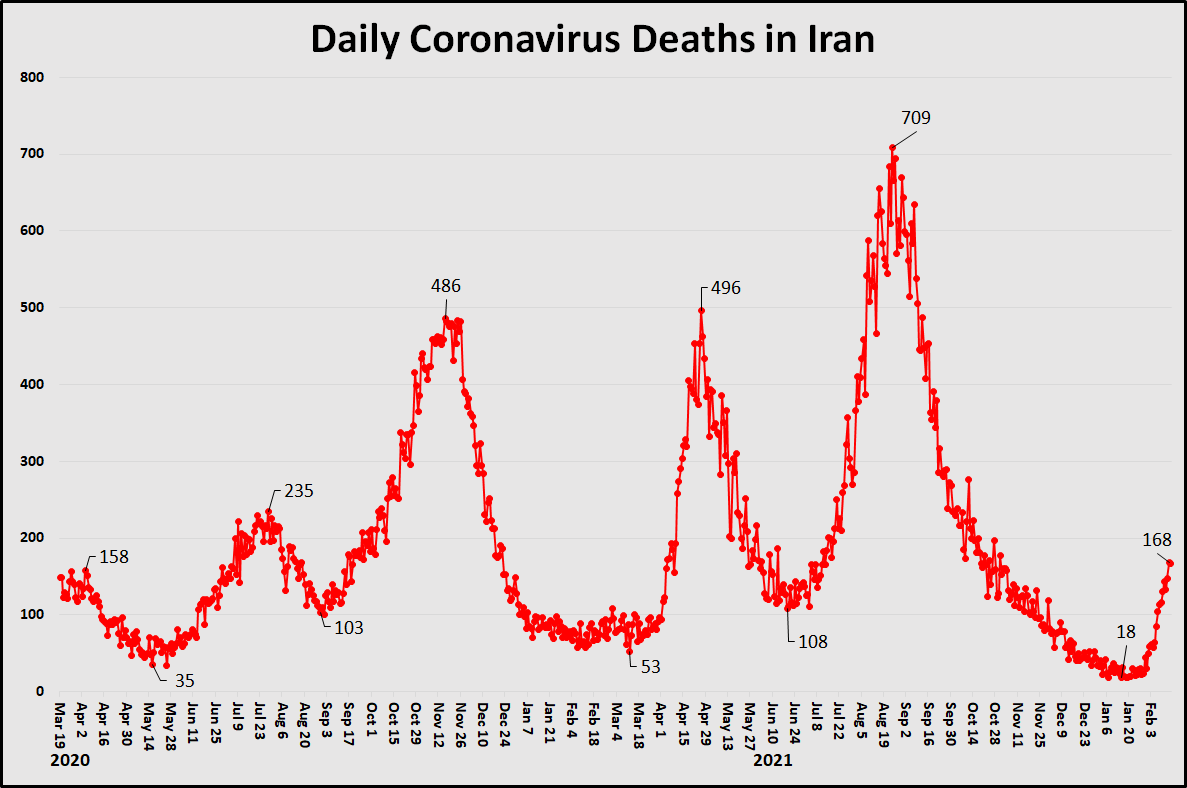
Over the first two years of the pandemic, more than 6.8 million people out of a population of 85 million contracted the virus. More than 133,500 people died.
Iran sporadically imposed border closures, lockdowns and travel restrictions. But it resisted the type of longer-term lockdowns imposed in some European and Asian countries. Masking became the norm in urban areas. But limitations on large events were unevenly enforced.
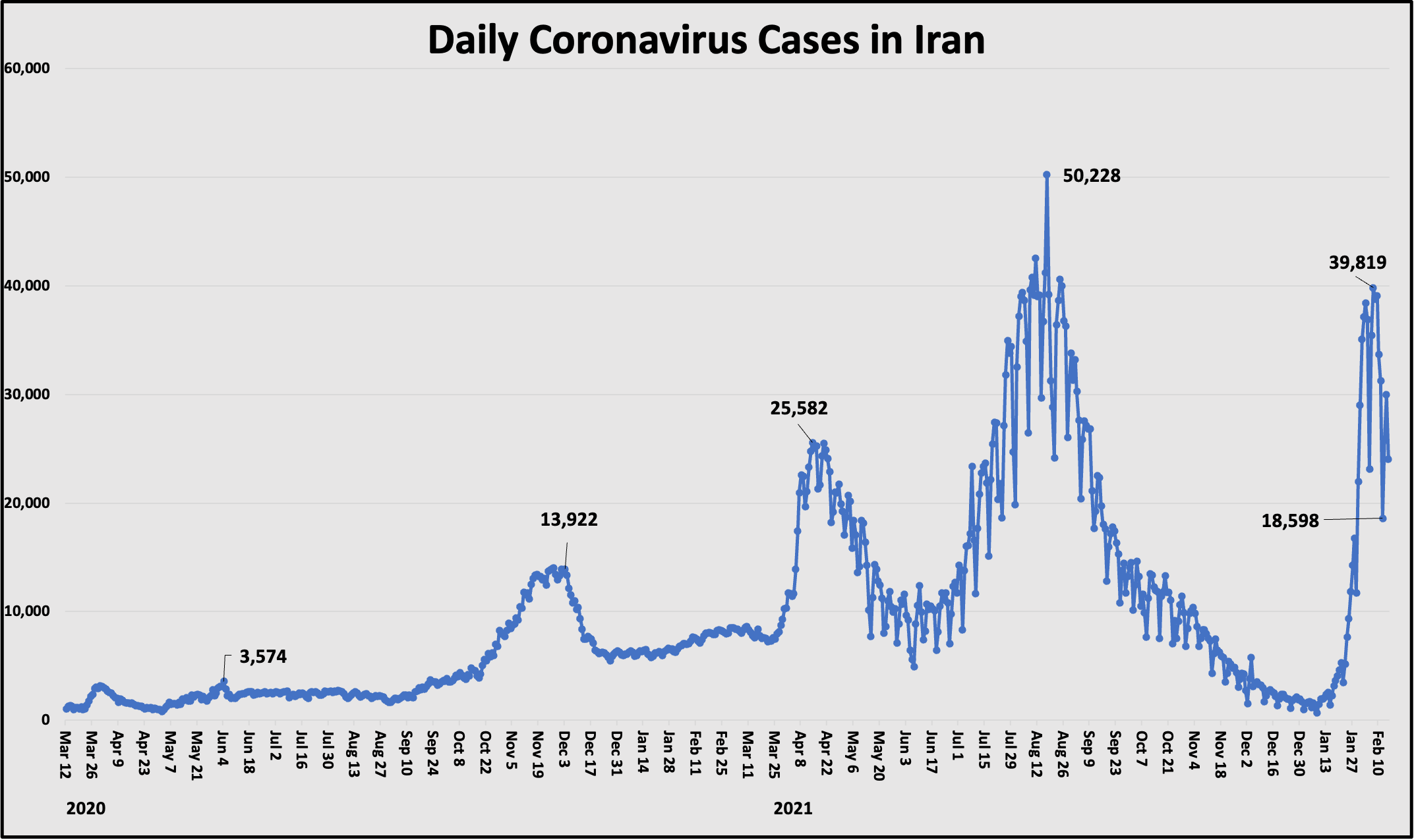
Iran faced three surges of infections before starting its vaccination campaign in February 2021. It began inoculating health care workers using Russia’s Sputnik V vaccine. Iran’s access to foreign vaccines was initially limited to Russian and Chinese vaccines in part because Supreme Leader Ayatollah Ali Khamenei had banned imports of American and British vaccines.
“They’re completely untrustworthy,” Khamenei said in a televised address in January 2021. “It’s not unlikely they would want to contaminate other nations.”
The vaccine rollout was slow in the last months of Hassan Rouhani’s presidency. Iran also struggled to mass produce its own vaccines. When the fifth and deadliest wave of infections, driven by the Delta variant, hit in July 2021, only 2 percent of the population had been vaccinated.
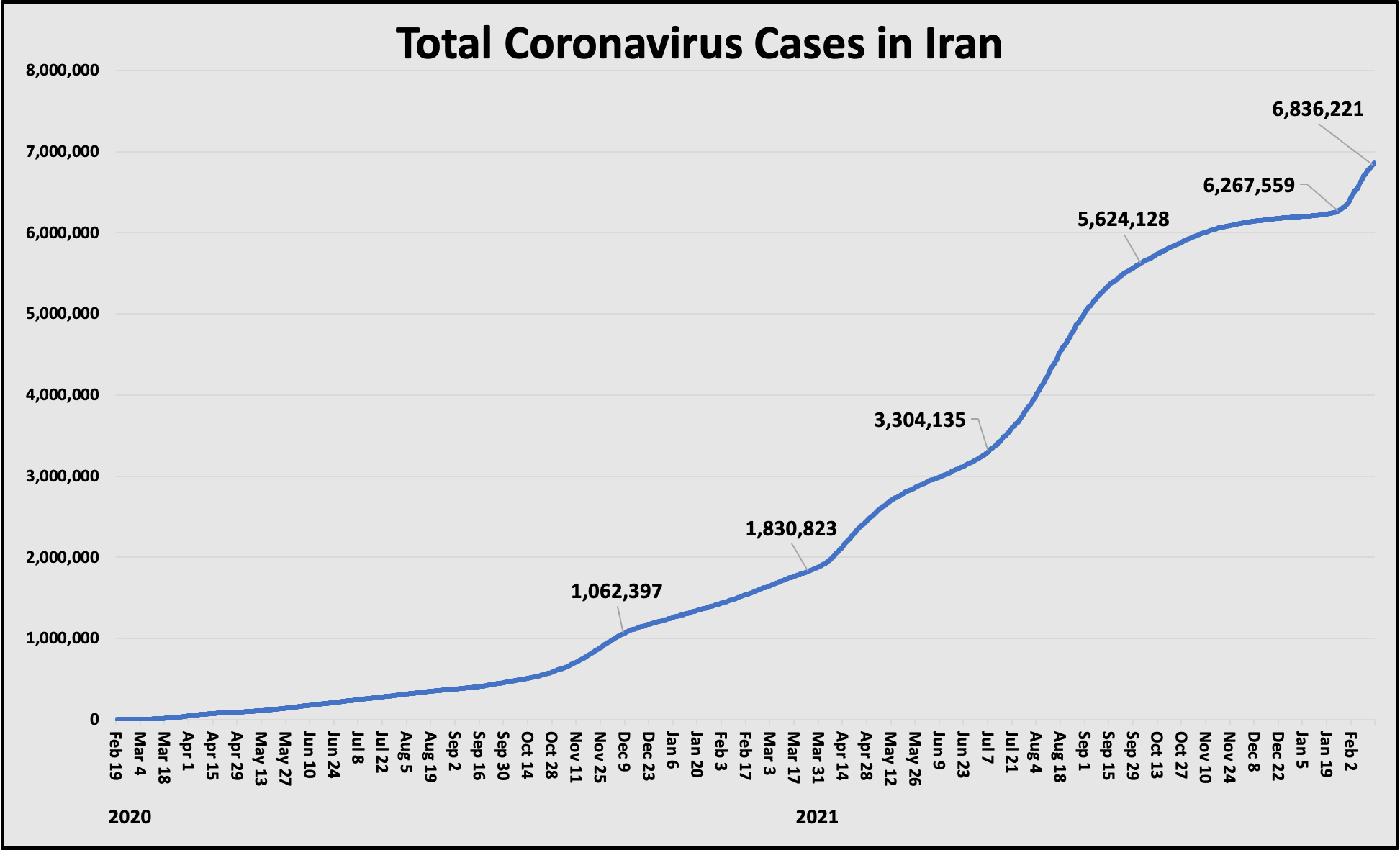
But President Ebrahim Raisi, who took office in August 2021, aggressively sought to import more vaccines and expand domestic production. Supreme Leader Khamenei also appeared to soften his position on Western vaccines. In August, Iran’s health ministry clarified that AstraZeneca, Moderna and Pfizer vaccines could be imported as long as they were not produced in the United States or Britain.
Iran gained access to foreign vaccines mostly through purchases and, to a lesser extent, donations. It also obtained vaccines through the U.N.-backed COVAX program. Between February 2021 and February 2022, Iran imported some 156 million vaccine doses, 86 percent of them China’s “Sinofarm.” Other major sources of vaccines included Russia, Japan and India.
Iran also worked on nine domestic vaccines. As of February 2022, four Iranian vaccines were approved for use. They included COVIran Barekat, Razi Cov Pars, Spicogen (jointly developed with an Australia-based company) and PastoCoVac (a collaboration between Iran’s Pasteur Institute and Cuba’s Finlay Vaccine Institute). But most of the administered doses were imported.
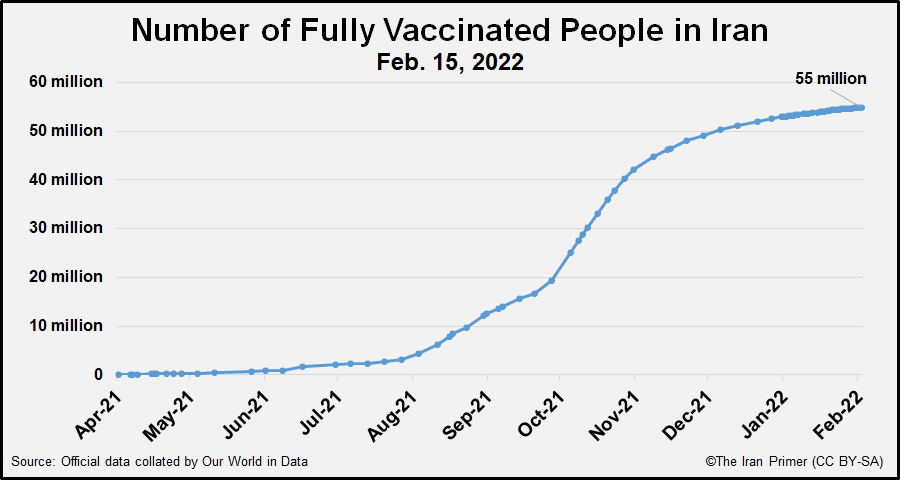
By the end of 2021, Iran’s vaccination rate was comparable to other countries in the region. “Today, on the 100th day of the government, I have to announce that more than 100 million doses of [COVID-19] vaccine have been injected,” President Raisi said in a live television interview on December 5. “Today we thank God that the death toll has dropped dramatically.”

A degree of normalcy began to return to Iran. Public schools gradually reopened for in-person instruction. In January 2022, Interior Minister Ahmad Vahidi announced the reopening of the remaining universities and schools that were primarily offering online instruction. Some 75 percent of students aged 12 to 18 were fully vaccinated.
But a sixth wave, driven by the Omicron variant, threatened another setback. “Unfortunately, with the increase in hospitalization and outpatient cases, we have to announce that we have practically entered the sixth wave,” Health Minister Bahram Einollahi said on January 27, 2022. The following is a timeline of the coronavirus outbreak in Iran.
2020
Week 1: February 16 – February 22
On February 19, Iran recorded its first case of the novel coronavirus.
Week 2: February 23 – February 29
On February 23, four of Iran's neighbors — Turkey, Pakistan, Afghanistan and Armenia — said that they would close their land borders. Afghanistan and Armenia suspended all air traffic, while Turkey halted arrival flights from Iran.
On February 24, President Rouhani assured the country that officials had “mobilized all of our resources” to contain the disease “in the shortest time with the minimum casualties.” Officials warned against overreacting to the outbreak, which they claimed was stabilized and under control. "We have managed to reduce the problem to the minimum," said Deputy Health Minister Harirchi.
Harirchi said that the government was against quarantines of Iranian cities, which he claimed could cause more harm than good. "With regard to quarantines – we are absolutely against them. Quarantines belong to pre-WWI – to the Plague, cholera, stuff like that," he said. "The Chinese themselves are not so pleased with the quarantine there. After all, quarantines have consequences. Let's suppose that you quarantine a certain city – what would the people of that city do? Look, we are carefully calculating all our decisions. We are analyzing and forecasting the effects of each decision we make. Let's assume that we shut down Qom for ten consecutive days. Everybody would go traveling, and this will cause the disease to spread all over the country."
But on the same day, Ahmad Amiriabadi Farahani, a lawmaker from Qom, accused the regime of covering up the true number of deaths and charged that the government had not done enough to stem infections. He reported that 50 people had died from the coronavirus in Qom. “So far, I have not seen any particular action to confront corona by the administration,” Farahani said.
On February 24, Harirchi refuted Farahani's claim during a press conference in which he appeared visibly sick, sweating profusely and using tissues to wipe his brow. "If it is confirmed that even half of this number is true, I will resign," Harirchi declared. A day later, the government reported that Harirchi had contracted the virus.
More than two dozen other officials also contracted the disease. Iranian health officials claimed that longstanding U.S. sanctions and the recent Financial Action Task Force’s decision to blacklist Iran had hindered the delivery of diagnostic test kits. “Multiple international companies are ready to supply Iran with corona (virus) test kits but we can’t send the money to them,” Ramin Fallah, vice president of the Iranian Union of Importers of Medical Equipment, said on February 24. Tedros Adhanom Ghebreyesus, director-general of the World Health Organization, called the sudden outbreak in Iran “very worrisome. We have to engage them even more.”
More than two dozen other officials also contracted the disease. Iranian health officials claimed that longstanding U.S. sanctions and the recent Financial Action Task Force’s decision to blacklist Iran had hindered the delivery of diagnostic test kits. “Multiple international companies are ready to supply Iran with corona (virus) test kits but we can’t send the money to them,” Ramin Fallah, vice president of the Iranian Union of Importers of Medical Equipment, said on February 24. Tedros Adhanom Ghebreyesus, director-general of the World Health Organization, called the sudden outbreak in Iran “very worrisome. We have to engage them even more.”
On February 25, U.S. Secretary of State Mike Pompeo accused Iran of covering up the extent of the outbreak. “The United States is deeply concerned by information indicating the Iranian regime may have suppressed vital details about the outbreak in that country,” Pompeo told reporters. “All nations, including Iran, should tell the truth about the coronavirus and cooperate with international aid organizations."
President Rouhani said that the virus was being used by Iran's adversaries to cause panic in the country. "In schools, high schools, universities and work places, everybody should pay attention to health recommendations, but we must all continue our work and activities, because it is one of the enemies' plots to spread fear in our country and close down the country," Rouhani said.
Afghanistan reopened its land borders with Iran after being closed for two days.
On February 26, President Rouhani urged the public not to let the virus become a "weapon" of the United States. "We must not let the United States attach a new virus to the coronavirus by stopping our social activities through tremendous fear; this is a conspiracy we see today and you see in foreign propaganda," he said.
Week 3: March 1 – 7
On March 2, France, Germany and Britain provided the Iranian government with nearly $5.6 million to help fight the country's coronavirus outbreak. The countries also pledged to deliver medical equipment through the World Health Organization and other U.N. agencies. "France, Germany and the United Kingdom express their full solidarity with all impacted by COVID-19 in Iran," the countries said in a joint statement. "We are offering Iran a comprehensive package of both material and financial support to combat the rapid spread of the disease."
On March 4, President Rouhani said that the coronavirus had spread to nearly every province. He criticized U.S. offers of provide humanitarian aid. “They [the United States] have appeared with a mask of sympathy that ‘we also want to help the people of Iran," he said. “If you are really telling the truth, then lift sanctions from medicine.” To document the number of coronavirus deaths, an Iranian secretly took video of bodies at a cemetery morgue. IranWire reported that he was subsequently arrested for recording without a permit.
Week 4: March 8 – 14
On March 8, four lawmakers called on the Supreme National Security Council to order a “mandatory quarantine of Tehran, Qom and other infected centers.” They also urged wealthy religious foundations to distribute medical supplies.
Iraq closed its land borders with Iran until March 15.
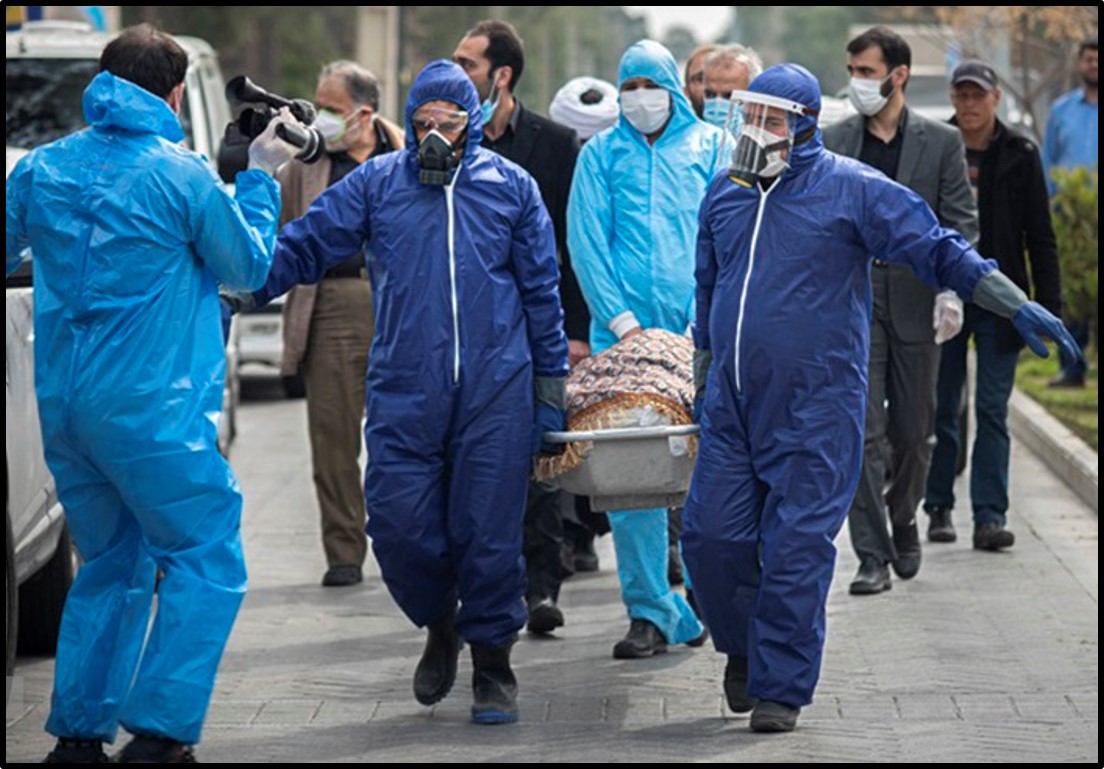
On March 9, a lawmaker from Kashan, which is situated between two areas with high concentrations of cases – Qom and Isfahan – asked the Health Ministry to order offices in in Kashan closed. Javad Sadati Nejad noted that the city’s two hospitals were already short on medical supplies. He made a personal request for residents to avoid leaving their homes.
On March 9, the supreme leader’s office announced that Ayatollah Khamenei would not travel to the holy city of Mashhad to give his Nowruz (Persian New Year) address. The statement cited warnings from public health experts to limit travel. In his annual speech, Khamenei discussed pressing challenges to the country, accomplishments from the previous year and his vision for the next year.
On March 11, Iran reported that five members of the IRGC had died from coronavirus.
On March 12, Iran asked the International Monetary Fund (IMF) for a $5 billion emergency loan to help fight the country's coronavirus outbreak. The IMF “has stated that countries affected by #COVID19 (coronavirus) will be supported via Rapid Financial Instrument. Our Central Bank requested access to this facility immediately,” Foreign Minister Zarif said in a tweet. Iranian Central Bank chief Abdolnaser Hemmati wrote IMF managing director Kristalina Georgieva to request financial aid.
In a separate letter to U.N. Secretary General Antonio Guterres, Foreign Minister Zarif urged the United Nations to demand that the United States lift sanctions on Iran. He said that the U.S. “maximum pressure” campaign was hampering Iran’s ability to cope with the COVID-19 coronavirus. “Although our medical facilities, doctors, nurses and other health practitioners are among the very finest in the world, we are stymied in our efforts to identify and treat our patients; in combatting the spread of the virus; and, ultimately, in defeating it, by the campaign of economic terrorism perpetrated by the Government of the United States,” Zarif wrote.
Week 5: March 15 – March 21
On March 15, the U.S. State Department Persian-language account tweeted a link to an anonymous survey via Telegram, an encrypted social media app, to encourage Iranians to provide information about the country's coronavirus outbreak. Within three days, the account received some 7,000 responses to the 37-question survey. An unnamed State Department official said that the tips were mainly about "particular facilities that people have seen coronavirus victims, particular regions, particular misstatements by the officials." The State Department intended to use the data to determine if Iran was under-reporting cases. "The picture painted is one of intimidation and mass falsifications of statistics," the State Department official said. "We are getting the unfiltered facts."
Iraq indefinitely extended the closure of its land border with Iran.
On March 17, President Rouhani unveiled a stamp commemorating the medical professionals fighting Iran's coronavirus outbreak. The stamp was inscribed with the words "National Heroes."
On March 18, Foreign Minister Zarif slammed U.S. sanctions, which he called "economic terrorism," in his annual Nowruz speech. He accused the U.S. government of inhibiting Iran's ability to contain the coronavirus outbreak. “When a nation’s right to access to medicine, food and other humanitarian items is violated, it will be placed on an unequal and more vulnerable position in comparison with the other countries," he said. "The U.S. is trying to ultimately turn our country into an isolated island in an ocean of threats and miseries through the constant increase in the layers and depth of the sanctions."
On March 19, five former health ministers urged the regime to take "fundamental steps" to stem the spread of coronavirus in Iran. In a letter to President Rouhani, the former officials, who are also medical doctors, called on the government to take immediate measures, including "limiting movement of people, holiday trips, shutting non-essential businesses and big shopping centers." The doctors said that all non-essential activities should be halted for at least two weeks. "The trend of the disease and its consequences continue to show an upward trajectory and it has not declined in any part of the country," they warned.
On March 20, IranWire published evidence of Iran’s delay in responding to early signs of the coronavirus. The report cited guidelines issued on February 19 by Iran’s Civil Defense Organization, which revealed that the government ordered a three-day delay in implementing measures to stem the country's coronavirus outbreak. Subsequent reporting claimed that the government wanted to ensure a large turnout in parliamentary elections on February 21. Separately, Gholamreza Jalali, commander of the Civil Defense Organization, sent a letter, dated January 31, to the armed forces’ chief of staff, the secretary of the Supreme National Security Council and the interior minister in which he acknowledged a COVID-19 outbreak in Qom. The government did not report cases to the public until February 19.
Week 6: March 22 – March 28
On March 22, Supreme Leader Ayatollah Khamenei called U.S. leaders "charlatans and liars" and rejected the U.S. offer to provide humanitarian aid to Iran. “Several times Americans have offered to help us to fight the pandemic. That is strange because you face shortages in America. Also you are accused of creating this virus,” Khamenei said. “I do not know whether it is true. But when there is such an allegation, can a wise man trust you and accept your help offer? ... You could be giving medicines to Iran that spread the virus or cause it to remain permanently.”
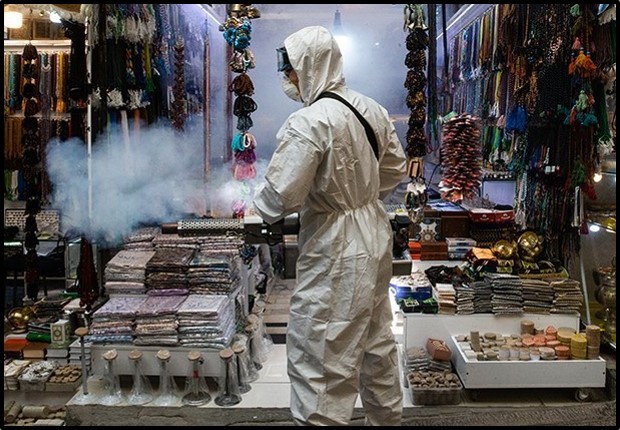
President Rouhani said that Iran would not accept U.S. humanitarian aid and called on the United States to lift sanctions to help fight the virus. “American leaders are lying ... If they want to help Iran, all they need to do is to lift sanctions .... Then we can deal with the coronavirus outbreak,” Rouhani said.
Hamidreza Goudarzi, the deputy governor of Tehran Province, ordered all businesses except for gas stations, pharmacies, supermarkets and bakeries to close indefinitely.
On March 23, the U.N. High Commission for Refugees delivered 4.4 tons of medical supplies to Iran. The shipment included masks, gloves and essential medicines. The U.N. agency said that additional humanitarian aid deliveries were scheduled "in the coming weeks."
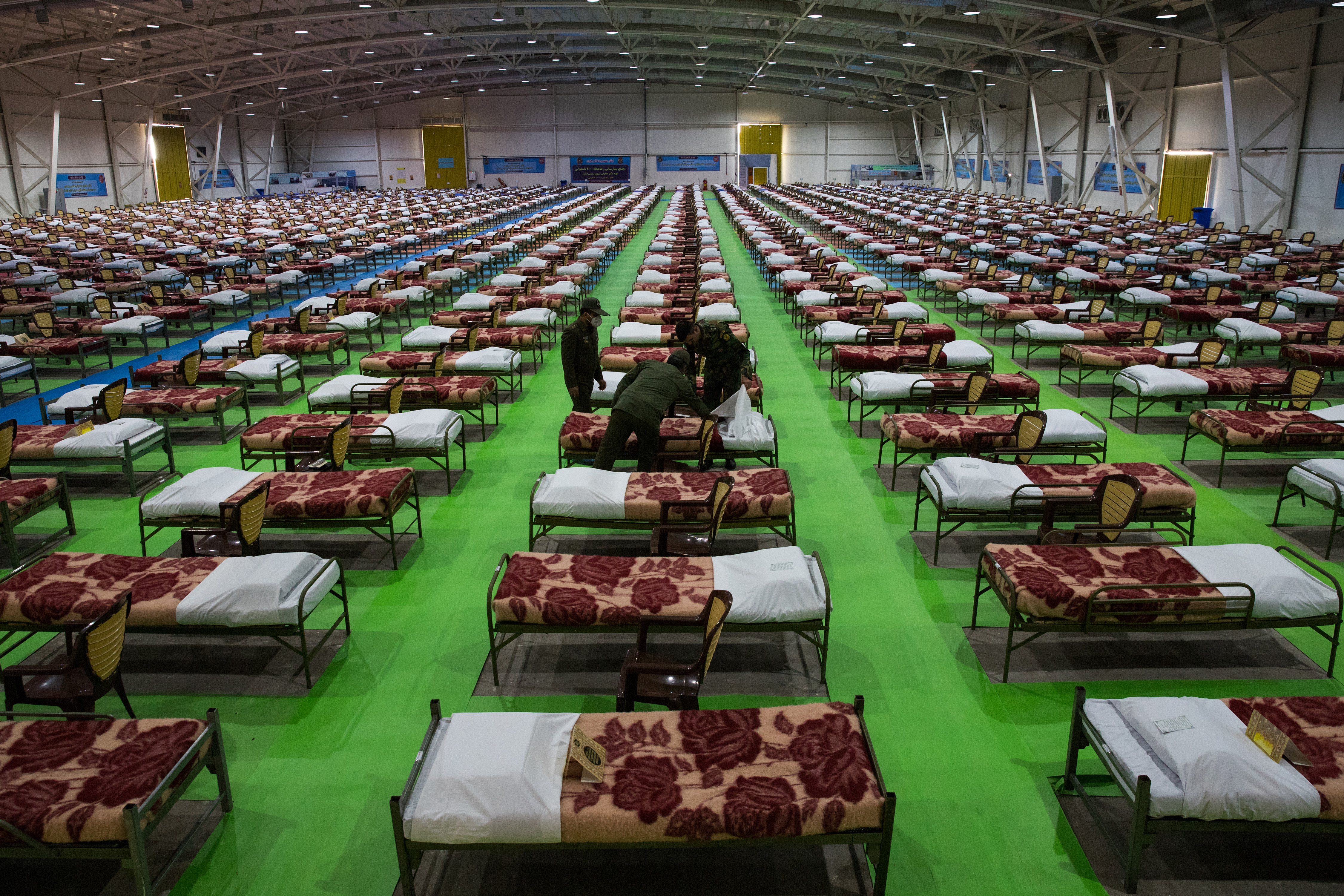
On March 24, President Rouhani announced that Iran would extend furloughs, from April 3 to April 19, that had been granted to 85,000 prisoners because of the pandemic. Tehran rejected humanitarian aid, including a 50-bed inflatable hospital and a 9-person emergency team, from Medecins Sans Frontieres (MSF) or Doctors Without Borders. “The Iranian Armed Forces' medical capabilities are entirely at its service, Iran did not need hospitals established by foreigners. The MSF presence in Iran is irrelevant,” said Ministry of Health advisor Alireza Vahhabzadeh. MSF said that the organization was "deeply surprised" to hear that the aid had been rejected. "The need for this intervention, and the authorizations needed to start it, were discussed and agreed with relevant Iranian authorities during the past weeks. Our teams were ready to start medical activities at the end of this week," said Michel Olivier Lacharité, manager of the MSF Emergency programs in Paris.
On March 25, President Rouhani said that Iran planned to implement a travel ban for the remainder of the two-week Nowruz holiday. "This plan is strict and it will create difficulties and restrictions for travel and prompt people who have already traveled to return home faster," he said. Rouhani added that all parks would be closed and Sizdah Bedar, an annual nature festival on April 1, "will not be like previous years."
Government spokesman Ali Rabiei warned that Iran could face a second wave of coronavirus cases if Iranians did not follow government orders. "Unfortunately some Iranians ignored advice from health ministry officials and travelled during the (Iranian) New Year holidays ... This could cause a second wave of the coronavirus," Rabiei said.
Iran announced that it would accept humanitarian aid from Medecins Sans Frontieres, a day after rejecting help from the international medical charity. "We thank Doctors Without Borders for their help. Their donated equipment will be used by the Ministry of Health in the areas where it is required," government spokesman Ali Rabiei said.
On March 28, President Rouhani said that Iran would allocate 20 percent of its new annual budget, or $6.3 billion (at free market values) to combat the COVID-19 outbreak. The allocation would include grants and low-interest loans to offset the impact of the virus.
Week 7: March 29 – April 4
On March 29, Deputy Health Minister Harirchi said that Tehran could not rule out the possibility that COVID-19 was a biological weapon deployed by the United States. He said that the Ministry of Health was conducting "serious investigations" into the matter. “If they just remove the barriers, we can provide the resources we need with oil and non-oil exports," he said.
President Rouhani urged citizens to continue with "the new way of life" in Iran, which he said could last for an extended period of time. "We must prepare to live with the virus until a treatment is discovered. The new measures that have been imposed are for everyone’s benefit. Our main priority is the safety and the health of our people," Rouhani said. He also appealed for national unity to fight the outbreak. "Another point I would like to say is that now is not the time for gathering teams and waging a political war; it is not about political war, nor party, nor ethnicity, nor national; but it is a public global issue," he said.
Foreign Minister Zarif accused the United States of waging an "economic war" on Iran. In a tweet, he said that sanctions amounted to war crimes.
On March 30, State Department Spokesperson Morgan Ortagus said that Iran's regime, not sanctions, were the problem. In a tweet, she claimed that the supreme leader had access to a "tax-free hedge fund" worth billions of dollars. The U.S. government had previously accused Khamenei of profiting from an "off-the-books" hedge fund, allegedly valued at $95 billion, called the Setad.

On April 1, President Rouhani said that Iran was successfully containing the outbreak. “Fortunately, the statistics I read last night from all the provinces shows a downward trend in all provinces,” he said at a cabinet meeting. Rouhani claimed that Iran’s increasingly strict travel restrictions and social distancing would curb infections without having to enforce the kind of lockdown used in Wuhan, China. His optimistic tone starkly contrasted with media reports that Iran’s healthcare system was severely overstretched.
On April 4, Deputy Health Minister Harirchi warned that Tehran could see a surge in coronavirus cases if citizens did not follow government guidelines. "We are still concerned about the virus, for example with the level of traffic in Tehran today and queues of cars stuck on freeways, because these people can take the virus to their homes or workplaces," he said.
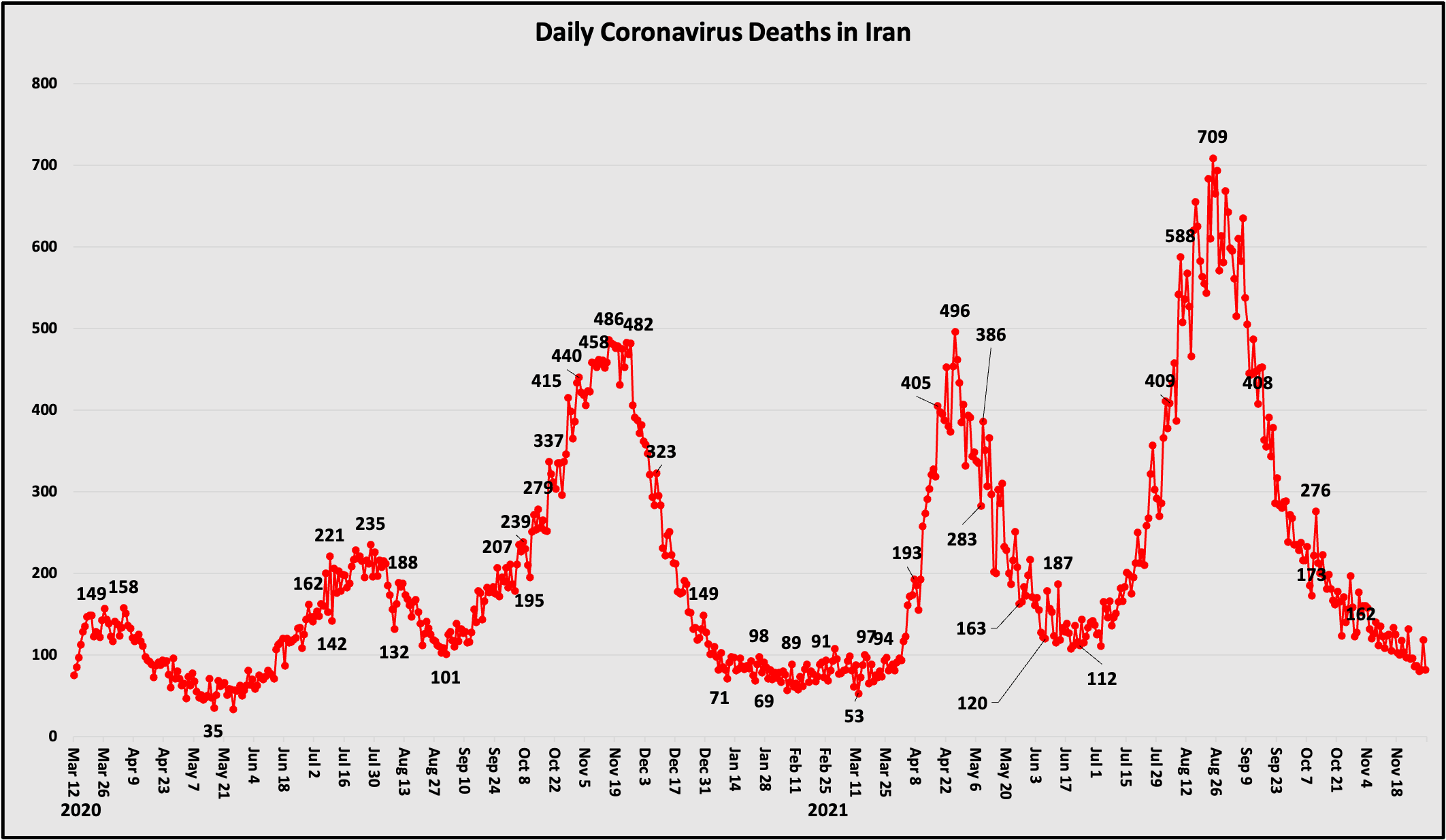
Week 8: April 5 – 11
On April 5, the government announced that low-risk economic activities would resume on April 11. President Rouhani added that high-risk activities, including classes at schools and universities and social, cultural, sports and religious events would be suspended until at least April 18.
On April 7, more than two-thirds of parliament’s 290 lawmakers gathered for the first time since February 25. They rejected an emergency bill requiring a one-month nationwide lockdown to stem further cases of the virus.
On April 9, Supreme Leader Ayatollah Ali Khamenei announced that mass gatherings during the holy month of Ramadan, beginning at the end of April, would be banned. “In the absence of these meetings, remember to heed your prayers and devotions in your lonesomeness,” he said.
On April 11, government offices in Tehran resumed operations with two-thirds of staff allowed to return. Low-risk businesses outside of Tehran , including shops, factories and workshops, were allowed to reopen. The government said that high-risk businesses — such as theaters, swimming pools, saunas, beauty salons, schools, shopping centers, and restaurants — would remain closed indefinitely.
Week 9: April 12 – April 18
On April 12, the government lifted restrictions on travel between cities within the same province. State media reported that travel between different provinces will be allowed beginning on April 20.
President Rouhani claimed that Iran handled the coronavirus outbreak better than Europe and the United States, despite the added burden of economic sanctions. "We had a sanctions virus, to which the coronavirus was added, but you [Europe and the United States] did not have the sanctions virus. You have one virus while we have two viruses," he said.
On April 14, Iran’s parliamentary think tank suggested that the infections and deaths from the COVID-19 virus could be nearly double the official count due to underestimates and poor testing. The 46-page report said that the Health Ministry only counted patients who had died in hospitals and tested positive for the virus. People who died in their homes were not included in the count, according to health experts.
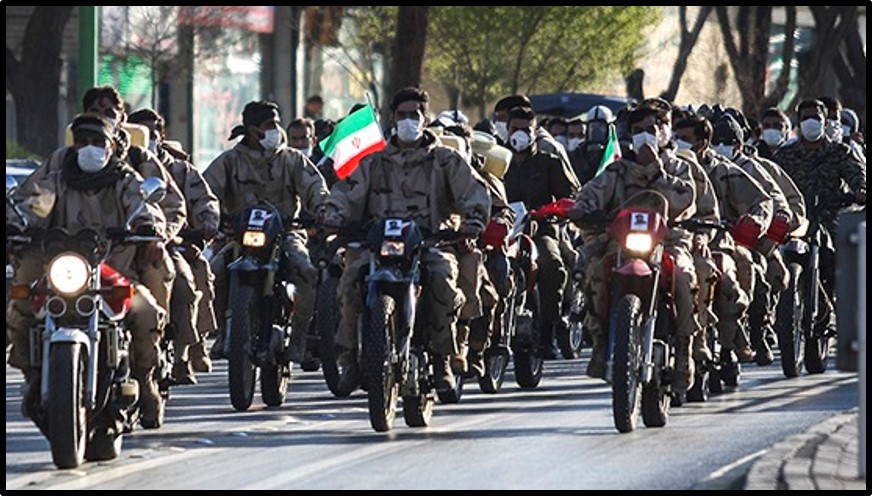
On April 17, Iran held a parade on National Army Day with a decidedly different focus. It featured disinfection vehicles, mobile hospitals and other medical equipment instead of the usual missiles, soldiers and warplanes. The “Defenders of the Homeland, Helpers of Health” parade, hosted at a training facility in front of senior commanders, highlighted the role that the military had played in combating the country's COVID-19 outbreak. President Rouhani said, “Due to health and social protocols, it is not possible to hold a parade of soldiers...The enemy now is hidden and doctors and nurses are (instead) at the frontlines of the battlefield.”
On April 18, crowds flocked to businesses as some shops, factories and workshops reopened in Tehran. The Grand Bazaar, covered markets and shopping malls remained closed. Traffic in Tehran was 70 percent higher compared to the same day the year before, according to Tehran's traffic police chief. "The consequences of today’s congestion will reveal themselves to medical centers five to 14 days from now," said Alireza Zali, head of Iran's coronavirus task force.
Week 10: April 19 – 25
On April 19, President Rouhani announced that mosques and holy sites would remain closed until at least May 4. "Decisions on gatherings during the (Muslim holy month of) Ramadan will be taken next week," Rouhani added.
On April 20, shopping malls and bazaars reopened in Tehran despite warnings from health officials. The Ministry of Health said that inspectors would be dispatched to ensure businesses were complying with government guidelines. “Everything depends on the degree to which people are respecting the health protocols. People should not think that the situation has become normal again,” said Mohammad Asayi, an adviser to the health minister.
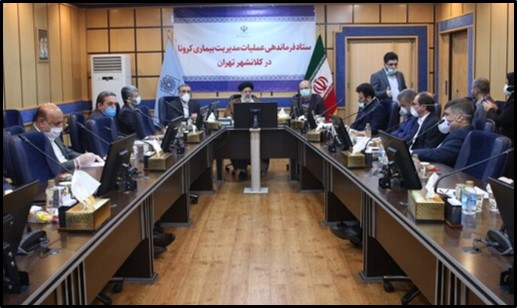
On April 22, Iran reopened public parks and recreational areas. The daily death toll had fallen below 100 for eight consecutive days.
On April 25, President Rouhani said that the country must prepare for the "worst-case" scenario — that disruptions from coronavirus could last until March 2021. “Our first request is that we should plan production long-term based on a pessimistic view that we might face this virus ... for months,” Rouhani said. "Maybe (we will face this) till the end of the year, we do not know."
Alireza Zali, Tehran's coronavirus coordinator, warned that a "hasty" lifting of restrictions could "create new waves of sickness in Tehran and complicate efforts to bring the epidemic under control."
On April 25, Pakistan reopened the Rimdan border crossing with Iran. At least 14 Iranian trucks carrying exports were allowed to cross into Pakistan the same day. The border had been closed since March 15 to stem the spread of the virus.
Week 11: April 26 – May 2
On April 26, President Rouhani announced that Iran would gradually begin to reopen religious sites in certain areas. Regions would be divided into white, yellow and red zones based on the number of COVID-19 infections and deaths. Counties that had been consistently free of infections or deaths would be labeled white, and mosques would be allowed to reopen. Deputy Health Minister Harirchi said that 116 counties had been designated as white and 134 as yellow.
On April 28, President Rouhani told Iranians to be cautious but not afraid of COVID-19. “Excessive fear, excessive anxiety, excessive worrying is worse than this corona itself and this virus and can really break up people’s lives and take away people’s comfort,” Rouhani said. “But at the same time we shouldn’t be careless, meaning there must not be excessive anxiety and worrying and there must be necessary caution.”
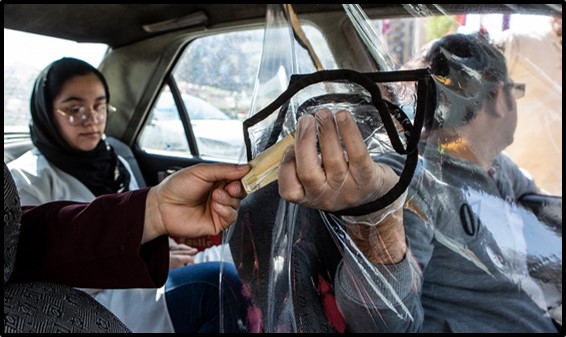
Deputy Health Minister Harirchi announced that all citizens would be required to wear face masks on the subway. He said that masks would be sold for cheap at the entrances to all metro stations.
On April 29, President Rouhani urged Iranians to learn to adapt to life under coronavirus indefinitely. “I’m telling our dear people, because it is not clear when this virus outbreak is over, we should stand ready to keep working and continue to acquire science and knowledge, conduct research, keep the society alive and give hope to the society, with the assumption that unfortunately this virus is here to stay with people for quite some time,” Rouhani said.
On April 30, Jamshid Hamzezadeh, the president of the Iranian Hoteliers Association, said that Iran's tourism industry had lost $330 million of revenue due to the COVID-19 pandemic. Hamzezadeh reported that hotels alone suffered $187 million in losses. He urged the government to exempt the tourism industry from paying taxes.
On April 30, the Ministry of Health announced that religious sites in several cities, including Qom and Tehran, would remain closed through the holy month of Ramadan. "Until there’s full assurance that pilgrims to religious sites will not face problems, we won't allow ourselves to open the doors of these centers to the people," said Health Minister Namaki.
Week 12: May 3 – 9
On May 3, the government designated 132 counties as white — or free of new COVID-19 cases. President Rouhani announced that mosques would be allowed to reopen in those counties on May 4. “The schools in the white and low-risk areas will reopen from May 16,” but he said the government would continue to review the numbers.
Deputy Health Minister Harirchi urged Iranians not to take COVID-19 lightly until a vaccine is developed. Iran had witnessed a decline in new cases and deaths due to government restrictions. “This falling trend in infections came by God’s grace and on the back of people’s cooperation and wholehearted efforts by personnel at all hospitals and laboratories, and all this has happened at a time when we are under unfair sanctions,” Harirchi said.
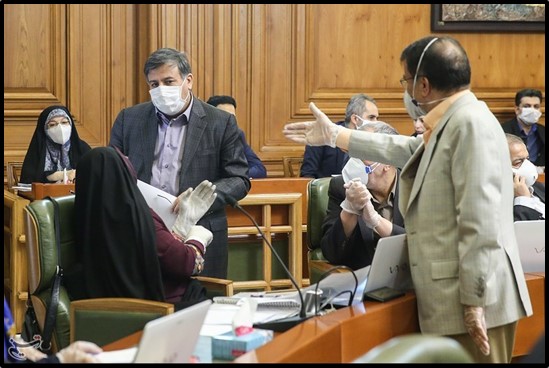
On May 4, Hossein Erfani, the director of the Contagious Disease Department at Iran’s Ministry of Health, warned that the country would likely experience a second wave of coronavirus cases in the autumn. “We predict that after a relative containment of the disease and its decline through the month of Khordad (May 21 – June 20), sporadic cases of the disease would occur in the society, but it will not be fully eradicated,” Erfani said.
Hojjatoleslam Ali Noori, the deputy head of the Policy-Making Council of Iranian Friday Prayer Leaders, announced that Friday prayers could be held in 157 cities after a two-month hiatus. Prayer leaders vowed to respect Ministry of Health guidelines.
On May 5, President Rouhani called on the United States to lift sanctions to help Iran fight its COVID-19 outbreak. “If the Americans are honest amid the conditions caused by the coronavirus and intend to take a measure (in Iran’s favor), the only way is for them to end the illegal sanctions on Iran,” Rouhani said in a phone call with Japanese Prime Minister Abe Shinzo. “Unfortunately, illegal US sanctions against the Iranian nation have intensified in the tough conditions of the fight against the coronavirus and its severe economic consequences.”
On May 6, the Ministry of Health reported that 15 out of the country’s 31 provinces were experiencing a resurgence in COVID-19 cases. The report noted that several tourist destinations—Isfahan, Gilan and Qom—had experienced a second wave of the virus after the government lifted travel restrictions in April.
The government unveiled a $260 million package to aid Iran's health sector. President Rouhani said that the funds were pulled from Iran’s sovereign wealth fund and would go toward the purchase of drugs, diagnostic kits and medical equipment needed to treat COVID-19 patients.
Week 13: May 10 – 16
On May 10, the government closed banks and offices in Abadan in Khuzestan province after the city experienced a sharp rise in new cases. Local officials also closed entry corridors to the city. Gholamreza Shariati, the governor of Khuzestan province, said that the increase was due to inadequate social distancing. “Because of this the number of corona patients in the province has tripled, and the hospitalization of patients has risen by 60 percent,” Shariati reported. Similar restrictions were implemented in nine other cities and towns in Khuzestan.
Supreme Leader Khamenei criticized the West's response to the COVID-19 pandemic. “The West and West-leaning entities wouldn’t like their failure [to counter the pandemic] to be seen, but it is necessary to study and explain the different dimensions of this failure,” he said. “Coronavirus began to spread in the United States and in Europe later than in other countries, which means they had the chance to prepare themselves to counter the virus."
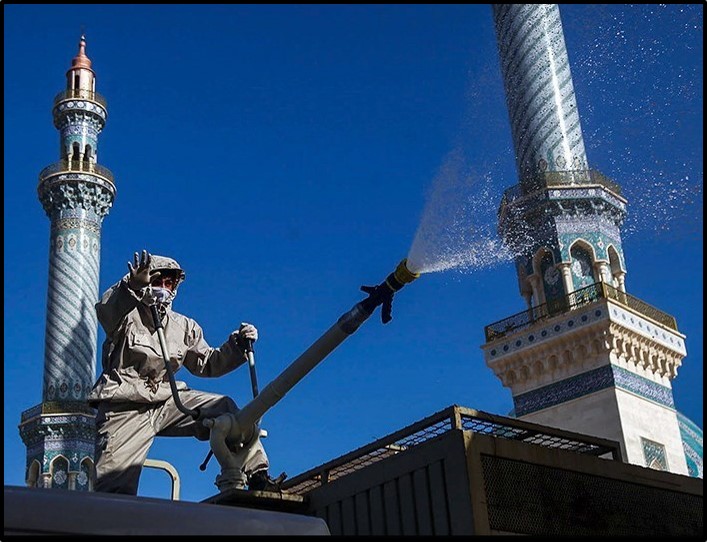
On May 11, Iran Air, the flagship airline, announced that it would partially resume international flights on May 14. Airline officials said that they had gained approval from authorities in the Netherlands to resume flights from Tehran to Amsterdam. Flights would be restricted to diplomats, aid workers, and those holding permanent residency in the Netherlands.
On May 12, the Ministry of Health temporarily reopened all mosques. Mohammad Qomi, the director of the Islamic Development Organization, said that mosques would remain open for three days commemorating specific nights during the holy month of Ramadan.
Health Minister Namaki announced that many regions had entered the "containment phase" in the Iran's fight against COVID-19. He urged citizens to continue to respect health protocols. "Our biggest strategic mistake in the current period is that we’d imagine that the coronavirus is over," Namaki said.
Iran’s transportation minister, Mohammad Eslami, announced that Uzbekistan and Turkmenistan had agreed to resume trade with Iran within 10 days after a two-month suspension due to COVID-19. Eslami said that the countries would implement health protocols on the borders including disinfection facilities for trains and trucks.
On May 13, President Rouhani praised the government's response to COVID-19. "The measures that we witnessed in Iran in the course of the battle with the coronavirus could disprove many judgments that were being made about the establishment, the government and people," he said. "The Westerners imagined that the Iranian nation would not withstand the pressures and sanctions for more than a few months, and after the outbreak of the virus, they thought that a country under tough sanctions and with limited financial sources could not endure such problems."
On May 14, President Rouhani called for solidarity from officials and the public to stem the spread of COVID-19. "I have said time and again that the unity and solidarity among officials at various levels and across the country as well as good cooperation from people were the most important factors, which were key to successful management and control of the deadly coronavirus," he said.
On May 15, the government allotted an additional $995 million to the Ministry of Health to fight the COVID-19 pandemic because the country had experienced an uptick in cases after restrictions were lifted in late April and early May.
On May 16, schools reopened in 130 cities deemed low risk or “white” regions after nearly three months of closure due to COVID-19. Students were required to wear masks and gloves during classes.
The government allocated more than $75 million dollars to Iranians unemployed due to the COVID-19 pandemic. Iran’s Plan and Budget Organization would transfer the funds to the Social Security Organization of Iran for dispersion.
Week 14: May 17 – 23
On May 17, Health Minister Namaki announced progress in Iran's fight against COVID-19. "The country has passed from the stage of managing and controlling the coronavirus disease and is moving towards containing it in most parts of the country," he said.

On May 18, Iran's Revolutionary Guards announced that the country's annual Quds Day parade, in support of the Palestinian claim to Jerusalem, would be cancelled due to COVID-19 concerns. The Guards had initially changed the parade from a pedestrian march to a parade of cars.
Government spokesman Ali Rabiei reported that 280 cities and towns had been declared low-risk white zones. He said that Khuzestan, which accounted for a quarter of the country's new daily cases, was the only region still in the high-risk red category. "We can have fewer deaths, keep people's daily lives in motion and not cripple the economy even when the coronavirus exists."
Health Minister Namaki condemned U.S. sanctions on Iran as "inhumane" in an address to the World Health Organization. "There is no doubt that unilateral sanctions constitute an obstacle and are an inhumane measure, which brings about suffering and pain,” he said. "The United States must be held to account for the severe sanctions that have put the lives of Iranian people in jeopardy."
On May 19, Iran reopened outdoor recreation centers and hiking trails. Minister of Cultural Heritage, Handicrafts, and Tourism Ali Asghar Mounesan said that camping and hiking in large crowds was still prohibited under the new guidelines.
On May 20, Iran announced that it would resume trade with Yemen, the United Arab Emirates, Qatar, Kuwait and Oman. Health Minister Namaki said that Iran would provide them with technical support in disease control.
On May 21, Iran reported that around 10,000 health workers had been infected by COVID-19. In April, the Health Ministry reported that more than 100 health workers had died from the virus.
President Rouhani said that neither the coronavirus nor U.S. sanctions could stop Iran's economic progress. "Coronavirus and problems like that cannot stop our production. Of course such problems have some impacts. Both the coronavirus and the US virus have impacts but none of them can stop us," he said.
Week 15: May 24 – 30
On May 25, President Rouhani announced the country's fourth phase of COVID-19 containment using diagnostic kits and other devices to separate the infected people.

Iran reopened holy sites — including Imam Reza shrine in Mashhad, Fatima Masumeh and Jamkaran mosque in Qom and Shah Abdol-Azim shrine in Tehran — after more than a two-month closure due to coronavirus. Worshippers were required to wear masks, walk through a disinfection tunnel and have their temperatures checked before entering. The shrines would only be opened to the public for six hours each day.
On May 26, "high-risk" businesses — including restaurants, cafes, gyms, saunas and wedding halls — were allowed to reopen across the country. Restaurants were required to ensure a distance of two meters (about 6.5 feet) between all patrons and only at 50 percent capacity.
All border crossings with Afghanistan were reopened and trade restrictions were lifted, according to Hossein Salimi, the chairman of Iran-Afghanistan Joint Chamber of Commerce. Afghanistan closed its land borders to Iran and limited trade on February 23. Land borders were officially reopened on February 25, but trade restrictions had remained in place.
On May 27, Iran’s new parliament, elected in February, held its first session amid the COVID-19 pandemic. All 268 members of parliament who attended had tested negative for the virus, according to state media. Lawmakers had their temperatures checked before entering parliament.
Iran reopened the Bazargan border crossing, which closed on February 24, between Iran and Turkey. Officials announced that Iraq would reopen the Shalamcheh border crossing with Iran the following week. Iraq closed its land borders with Iran on March 8 due to COVID-19.
On May 30, Iran reopened mosques for daily prayers. Restrictions on the opening hours for shopping malls were lifted. ed countries of the world," he said. "Today, after having fought this dangerous virus for 100 days, during which our health sector and the entire nation did a great job, we see acceptable conditions [in terms of containing the pandemic].”

Week 16: May 31 – June 6
On May 31, President Rouhani praised Iran's response to the COVID-19 outbreak. "Our country’s statistics and figures as well as the economic fallout of coronavirus are comparable to develop
On June 1, Health Minister Namaki warned that Iran could face a stronger second wave of infections if people did not follow health guidelines. "The outbreak is not over yet and at any moment it may come back stronger than before," Namaki said in a news conference. "If our people fail to respect the health protocols ... we must prepare ourselves for the worst situation."
On June 2, Health Minister Namaki expressed concern that Iranians had become "completely careless" with regard to the COVID-19. "If we neglect the situation, we will go backwards," he said. "People, have mercy on us, let’s have mercy on ourselves, government officials are getting tired."
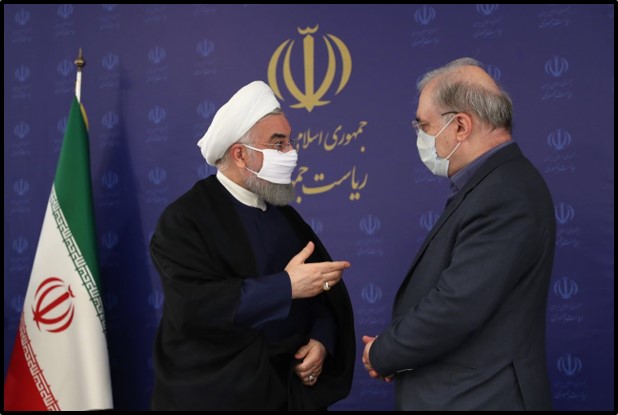
On June 3, President Rouhani warned that Iran would reimpose restrictions if a second wave of infections hit the country. "If in any part of the country these warnings aren’t taken seriously and God forbid the outbreak of illness peaks again, the authorities will have to reimpose restrictions," he said. "This issue will create problems for the ordinary life of citizens and will also bring serious economic damage to the society." He urged Iranians to avoid nonessential travel.
On June 5, Iran's tourism ministry announced that the country could reopen to foreigners by mid-summer. "Based on our tourism marketing program monitoring and data analysis from the neighboring countries, the Persian Gulf littoral states, and the European Union, an initial forecast suggests that Iran will open land borders to neighbors as of 15th of Tir (July 5) and some of its air borders as of 1st of Mordad (July 22)," said Mohammad-Ebrahim Larijani, the director of the ministry’s advertising and marketing office. "We are constantly monitoring countries and we have decided, in the first phase, to resume tourism interactions with the neighboring countries."
On June 6, President Rouhani warned that the COVID-19 outbreak was not over. "The period of the coronavirus epidemic is going to be long, and we don’t know when it will end; under such circumstances, health directives must be closely observed," Rouhani said. "Meeting the needs in the health and treatment sector to fight coronavirus, supplying necessary services to society, providing basic and essential goods, and supplying stimulus packages to low-income families are four main duties of the government, and the trend of discharging all these responsibilities is going well."
President Rouhani blamed a wedding party for the latest surge in COVID-19 cases. “At one location, we witnessed a peak in this epidemic, the source of which was a wedding that caused problems for the people, health workers and losses to the economy and the country’s health system,” Rouhani said on state television.
President Rouhani announced that theaters and concert halls would reopen on June 21. The Ministry of Health limited seating capacity to 50 percent for all venues.
Week 17: June 7 – 13
On June 7, the Ministry of Health said that Iran's spike in coronavirus cases was due to increased testing. "The main reason for rising numbers is that we started identifying (infected people) with no or light symptoms," said Mohammad-Mehdi Gouya, the health ministry's head epidemiologist. He added that it was normal for a slight rise in infections after reopenings.
Iran announced that it would allow foreign students to return to universities in Iran on September 5. Abdolhamid Alizadeh, the director general of the Iranian Science Ministry’s office of foreign students, said that 15,680 foreign students had left Iran in March due to the coronavirus outbreak.
On June 8, Health ministry spokesman Kianoush Jahanpour urged citizens to wear masks to stem a second wave of coronavirus infections. "Everybody must wear masks when attending places like stores or any other place where it is not possible to observe social distancing carefully," Jahanpour said on state television.
On June 9, the Ministry of Health estimated that about 15 million Iranians, nearly one in fifth of the population, had been infected with COVID-19. This means the virus was "much less lethal than we or the world had anticipated," said Ehsan Mostafavi, a member of the country's COVID-19 task force.
Health Minister Namaki dismissed Health Ministry spokesman Kianoush Jahanpur after several of his controversial tweets and comments to the media. Namaki said that the spokesperson was required to get approval before expressing personal opinions on social media. Dr. Sima Sadat Lari, the Students Affairs Deputy of the Ministry, was appointed as the new spokesperson. Namaki urged Lari to refrain from "political games" and concentrate on the ministry's mission.
#Iran’s Health Ministry new spokeswoman: Total #CoronaVirus cases in Iran are now 175,927 & number of deaths 8425. As of yesterday 2095 new infections & 74 deaths reported. 138,457 have so far recovered from #COVID19 & 2639 are in critical condition. 1,128,601 tests done so far. pic.twitter.com/yBmWTpKWQl
— Abas Aslani (@AbasAslani) June 9, 2020
Ehsan Mostafavi, the head of the Research Center for Emerging and Reemerging Infectious Diseases at the Iran's Pasteur Institute, said that Iran had a lower mortality rate than many other countries because of its young population and widespread testing. "One determining factor is the younger population of the country. The median age in Iran is 31, while it’s 45 in Spain and 47 in Italy," Mostafavi said.
On June 13, President Rouhani urged citizens to continue to adhere to health protocols, warning that the population had not reached "collective immunity" from the virus. "No matter how advanced the country is, the number of beds and medical facilities as well as medical personnel is limited, so everybody should keep observing directives," Rouhani said.
Week 18: June 14 – 20
On June 14, Iran recorded 107 deaths from COVID-19, the country's largest daily increase in fatalities since April 13. "Today it was very painful for us to announce a triple digit statistic... This virus is unpredictable and shifting," said Health Ministry spokeswoman Lari. "Observe health protocols, take social distancing seriously, avoid gatherings and trips that aren’t essential and, God willing, in the coming days we will see the statistic come down into double digits and even single digits."
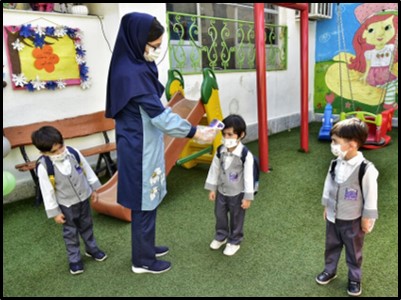
On June 15, Iran reopened kindergartens across the country. The Ministry of Health restricted capacity to 50 percent and required all children to have their temperatures checked before entering the classroom.
Government spokesman Ali Rabiei warned that Iran may have to reimpose restrictions after a surge in coronavirus infections and deaths. "In the (Tehran) subway, although 90 percent of passengers use masks, social distancing is not being observed," Rabiei said during a news conference. If the virus spreads is out of control, the government would have to apply strict limitations again.
On June 16, President Rouhani said that Iran was engaged in two separate battles, one against COVID-19 and another against "cruel and inhumane" U.S. sanctions. "One of the country’s glories in simultaneous handling of the sanctions and the coronavirus has been fulfillment of the necessary needs of people in the market, in such a way that we prevented the inhumane dream of those imposing sanctions from coming true, which was causing problems and distress in the daily economic lives of people and the supply of items they need for livelihood," Rouhani said.
On June 17, three prominent Iranian physicians wrote to President Rouhani urging him to prioritize "preserving people's lives and health to everything else." The doctors called on the government to reimpose health restrictions to stem the country's second wave of infections.
On June 18, President Rouhani said that the coronavirus outbreak has not stopped Iran's economic progress. He pointed to several new national projects in the transportation industry. "Thank God, we are witnessing very good movements in the maritime routes and the ports, particularly in Chabahar, as well as in the railroad and land transportation," Rouhani said at a project inauguration ceremony in Tehran.
On June 20, President Rouhani said that Iran may require citizens to wear masks in public places. "Mainly for crowded and covered areas...we may make (masks) compulsory in a week, more or less. But first plenty of inexpensive masks should be made available for the people," he said on state television.
Week 19: June 21 – 27
On June 21, Health Minister Namaki said that Iran was still battling the first wave of COVID-19 infections. "The peak of the disease has not passed. The coronavirus is a tricky virus with a hundred thousand faces. A protocol for treatment may be effectual in one region, but ineffective in another area," he warned.
On June 22, Education Minister Mohsen Haji Mirzaei announced that students at large schools would begin attending school on alternate days in the new school year.
Health Minister Namaki said that 87 percent of Iranians who had died from COVID-19 were obese or had underlying medical issues.
On June 23, Iran reported 121 new fatalities from COVID-19, the country's highest daily increase in deaths since April 11. After a decrease in deaths in May, daily fatalities related to COVID-19 slowly increased in June.
On June 24, Deputy Health Minister Raeesi announced that 40 percent of residents in Qom and Gilan provinces and 15 percent of residents in Tehran province had contracted COVID-19. He added that the extent of infections in Iran's other provinces was between four and five percent. Health Minister Namaki said that Iran was working toward developing its own vaccine. "We have made good progress, but it is still too early to unveil our work,” Namaki told reporters. The Health Ministry said it was offering free COVID-19 tests to anyone with symptoms.
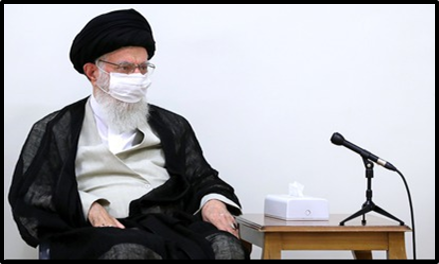
On June 26, Ali Asghar Mounesan, Iran’s minister of cultural heritage, tourism and handicrafts, said that country's tourism industry had started to recover from the COVID-19 pandemic. "Local tourism in the country has now begun with all the health protocols in place, and, as of early August, with the plans that have been made, we will see the presence of foreign tourists in the country again," Mounesan said in a radio interview.
Musa Alizadeh-Tabataee, Iran’s deputy ambassador to Iraq, announced that all border points with Iraq would be opened soon. He said that 80 percent of the crossings were already open with new health protocols. Other points along the southern border were still closed, he added.
On June 27, Supreme Leader Ayatollah Khamenei warned that Iran's economy could further deteriorate if the country did not stem COVID-19. "Something must be done to prevent economic problems caused by the coronavirus," he said in a meeting with judiciary officials. "But in the case of negligence and significant spread of the disease, economic problems will increase, too."
The Ministry of Health launched an “#I_wear_mask” campaign to promote health protocols on social media. "I desperately - and in a friendly way - plead with people to cooperate in observing medical protocols for their own sake and that of others," Deputy Health Minister Harirchi told reporters. "Every 33 seconds one Iranian is infected with the coronavirus and every 13 minutes one dies from it."
Week 20: June 28 – July 4
On June 28, President Rouhani announced that all citizens would be required to wear masks at indoor gatherings starting on July 5 to stem the spread of COVID-19. The new protocol would remain in effect until July 22.
On June 30, President Rouhani warned that the coronavirus would likely linger in the country throughout the Persian year, which ends in March 2021. "Watchfulness and observance of the health principles must still be on the agenda of everybody, and attending the unnecessary gatherings must be avoided," Rouhani said. "Despite all efforts and the very good measures that have been taken in the fight against the disease and for the treatment of the patients, we still witness an increase in the number of infections in a number of cities because the coronavirus is unknown."
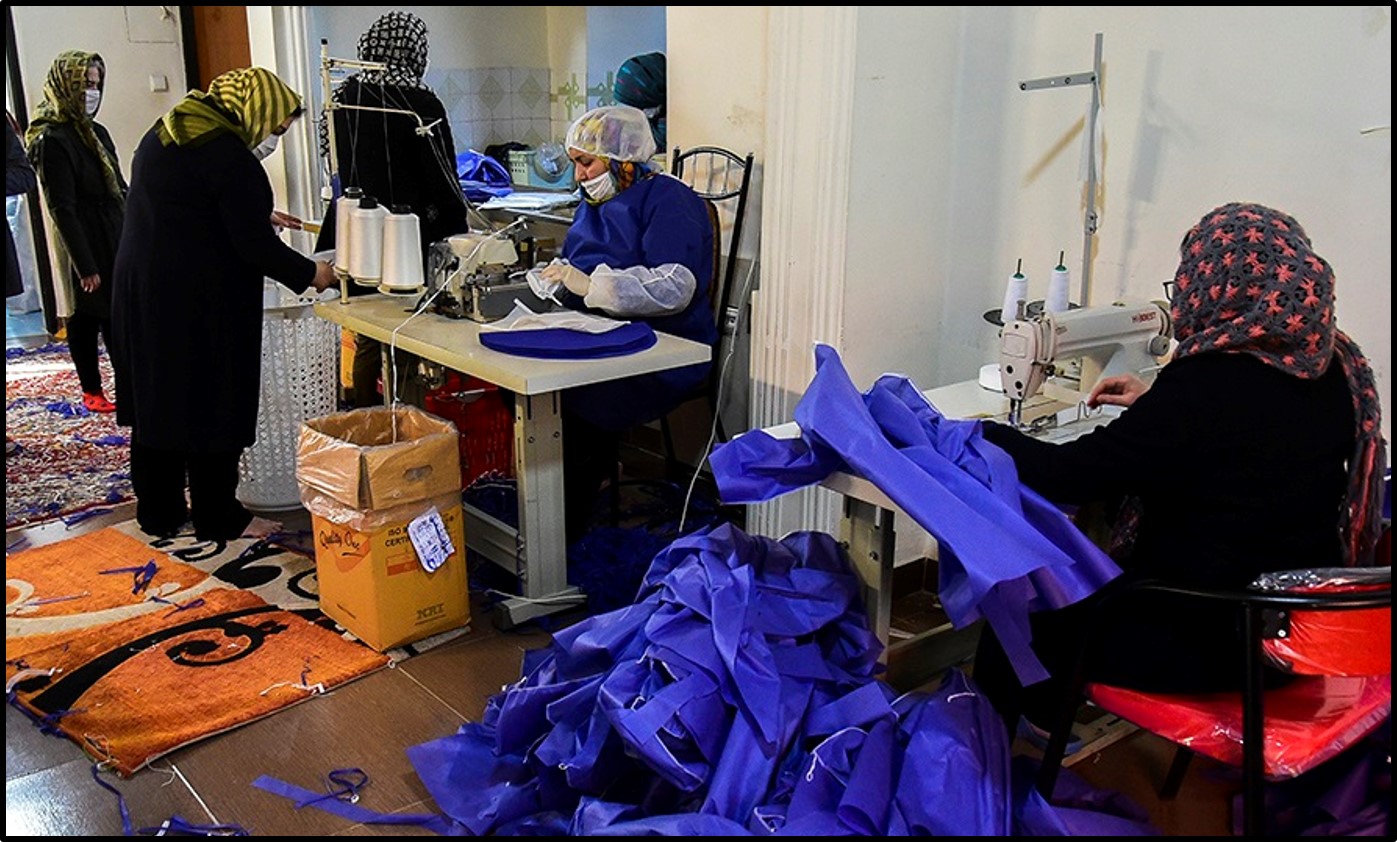
Iran announced that a homegrown COVID-19 vaccine would undergo human clinical trials "in the not too distant future." Health Minister Namaki said that the vaccine had already passed laboratory tests with animals.
On July 1, the Ministry of Cultural Heritage, Tourism, and Handicrafts held a meeting to determine rules for foreign tourists. "Given the fact that some countries, especially neighboring countries, are gradually re-opening borders, the Islamic Republic of Iran needs to take action to define comprehensive health protocols," said Vali Teymouri, the deputy tourism minister.
On July 3, Iran reintroduced a week-long lockdown on seven cities in the southern province of Hormuzgan, including Bandar Abbas, one of the country's biggest port cities on the Persian Gulf. The shutdown included all schools, universities, most offices, cinemas, restaurants, public pools, gyms and parks. Hormozgan Governor General Fereydoun Hemmati said that the province had experienced an uptick in cases and fatalities due to tourists and overcrowded bazaars.
On July 4, President Rouhani warned citizens not to hide infections. "If someone knows that they have been infected with coronavirus, they have a religious and human duty to inform others about it," Rouhani said. "If somebody has found out that another person is infected, they should reveal it, so that we will be able to get through this problem."
Week 21: July 5 – 11
On July 6, Iran banned the export of face masks amid an uptick in infections. Jamshid Golpour, head of the Industry and Trade Ministry’s Center for Guilds and Businesspeople, called on vendors to increase domestic sales of masks. “Producers are expected to provide distribution networks with standard masks at already approved prices," he said.

On July 7, Iran reported 200 new deaths, exceeding the previous record of 163 deaths on July 5. "I repeatedly said to our people that it’s extremely dangerous to understate the situation," Health Minister Namaki said on state television. "Unfortunately, our pleas fell on deaf ears until we were gripped by a new wave."
On July 8, Health Minister Namaki blamed "criminal" U.S. sanctions for Iran's struggles to contain COVID-19. He also criticized Iranian officials, accusing them of "negligence," having no economic plan, and "losing control" of the outbreak. "This country’s president must think about the people’s livelihood. This country’s administration, the security forces, the law enforcement, and the military forces must think about the livelihood and how to prevent an insurrection," he said.
Iraq partially reopened the Shalamcheh border crossing with Iran after more than three months. Trade was restricted to 500 trucks per week to transport food and other essential items. Both governments implemented new health protocols at the border.
On July 9, Iranian Parliament Speaker Mohammad Baqer Qalibaf accused the United States of hampering Iran's efforts to fight COVID-19. He called on the international community to condemn "inhumane" U.S. sanctions. "Since the outbreak of the dangerous virus, despite pressures and calls from international organizations to halt or reduce the U.S.-led sanctions against various nations, including Iran, Washington’s maximum pressure has been on the rise," he said.
General Hossein Salami, the IRGC commander, called on citizens to follow health protocols. "The coronavirus is not weakening and is still active, affecting new areas every day, and we should not show weaknesses," Salami said. "As no decisive treatment currently exists, we can only tackle this disease by following the health protocols and taking preventive measures."
On July 11, President Rouhani warned that a nationwide lockdown could disrupt economic activities and prompt protests. "The easiest option is to shut down everything," he said. "But then people will pour into the streets because of hunger and unemployment." But he did call for a ban on weddings, funerals and other ceremonies. "Now is not the time for festivals or seminars," he said. Shortly after Rouhani's speech, Ali Reza Zali, the head of Tehran’s virus task force, announced a ban all conferences, festivals and exhibitions and restricted wedding and funeral ceremonies to 10 people. The number of COVID-19 testing centers in the capital was also almost doubled, from 56 to 90, as the pace of the pandemic accelerated.
Hossein Qenaati, an advisor to Iran’s Coronavirus Task Force, said that between 50,000 and 60,000 Iranians could die from the virus if the public did not adhere to health protocols. "The second wave, which will occur in the fall, will be much more deadly," Qenaati warned.
Week 22: July 12 – 18
On July 13, Supreme Leader Ayatollah Khamenei called the resurgence of COVID-19 "truly tragic" in a virtual meeting with lawmakers. Khamenei urged all citizens to "play their part in the best way to break the chain of transmission in the short term and save the country."
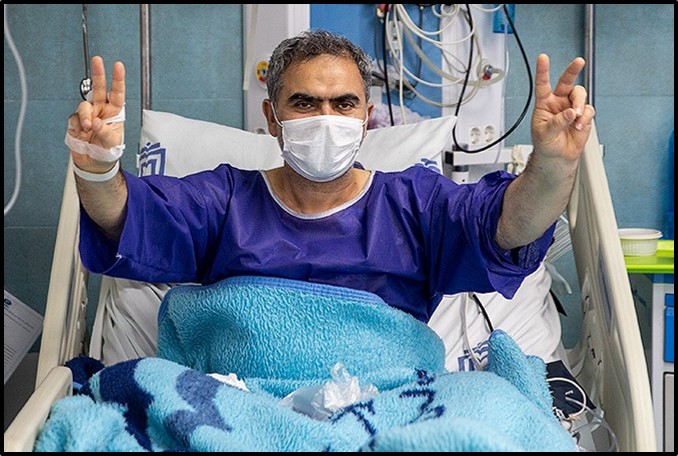
On July 14, Anushirvan Mohseni Bandpay, the governor of Tehran Province, reimposed a week-long lockdown after a spike in COVID-19 cases and deaths. The new restrictions, made in coordination with the National Coronavirus Task Force, shutdown all universities, schools, seminaries, libraries, theaters, museums, ceremony halls, barbershops, beauty salons, mosques, cafeterias, coffee shops, zoos, amusement parks, indoor swimming pools, and fitness centers. Bandpay also declared a ban on social, cultural and religious gatherings.
Health Ministry spokesman Lari announced that 12 provinces had been declared "red zones" — up from nine — due to high rates of COVID-19 infections. The red provinces included Khuzestan, West Azarbaijan, East Azarbaijan, Khorasan Razavi, Zanjan, Kurdistan, Kermanshah, Golestan, Hormozgan, Ilam, Bushehr, and Mazandaran.
Mahmoud Abbasi, the Deputy Justice Minister for Human Rights and International Affairs, said that anyone who had knowingly spread COVID-19 should be hanged. "Someone who is fully aware of his infection and without wearing a mask sneezes and coughs…spreads the coronavirus to others and ultimately causes their death. This means deliberate murder and is subject to Qisas," Abbasi told a local news outlet.
On July 15, Health Minister Namaki announced that Iran would begin producing Remdesivir, an antiviral agent proven to treat COVID-19, within a week. Iran had previously relied on humanitarian imports to receive the drug.
On July 16, Reza Jalili-Khoshnood, a senior official on Tehran’s anti-coronavirus task force, warned that the country was facing a shortage of medical staff and beds. He said that 172 medical personnel had been infected at Tehran’s Shohada hospital alone.
Iran’s Friday Prayers Committee announced that Friday prayers were cancelled in Tehran due to the increase in COVID-19 cases and deaths in the city. Prayers were allowed to continue in provinces deemed “white zones” due to low numbers of infections.
On July 18, President Rouhani said that 25 million Iranians may have been infected with COVID-19 and about 14,000 had lost their lives, based on a Ministry of Health study. “There is the possibility that between 30 and 35 million more people will be at risk.”
President Rouhani said that the country’s COVID-19 outbreak had probably started in Qom and Gilan provinces, where people who had traveled to Wuhan, China spread the virus to students and tourists. He blamed the second wave of infections on the public’s refusal to adhere to government-imposed health protocols.
The governor of Khuzestan announced that 22 cities in the southwestern province would be placed under a three-day lockdown to stem the spread of the virus. Khuzestan had some of the highest rates of infections and deaths in the country.
Week 23: July 19 – 25
On July 19, Turkey suspended all flights to Iran due to the increase in COVID-19 cases.

On July 21, Iran recorded 229 new deaths from COVID-19, the largest one-day increase in deaths.
On July 22, Iran unveiled the domestic production of two drugs — “Remdesivir” and “Favipiravir” — to help treat COVID-19 patients.
On July 23, Health Minister Namaki told the World Health Organization (WHO) that Iranian scientists had made progress in a COVID-19 vaccine. It “passed the initial tests and (we) hope to reach promising stages,” Namaki said.
On July 24, Iraq reopened the Khosravi border crossing with Iran after four months.
Abbas Mousavi Motlaq, the Friday Prayer Imam in Qom, said that COVID-19 was a “secular virus” that was corrupting religious countries. “With its destructive effects coronavirus is trying to lead religious countries astray, and toward atheism,” he said.
Week 24: July 26 – August 1
On July 25, President Rouhani urged citizens to be cautious during celebrations for the Islamic holiday of Eid al Adha. “Let glorious festivities be held in mosques and religious centers by observing health protocols and social distancing,” Rouhani said. Deputy Health Minister Harirchi urged people not to travel to the holy city of Mashhad during the festivities because it had a 300 percent increase in COVID-19 cases in the previous month.
In an open letter, Tehran’s Coronavirus Task Force asked Health Minister Namaki to allow half of the city’s government employees to work remotely. Under protocols at the time, only one-third of Tehran’s government employees were permitted to work remotely.
On July 26, Health Ministry spokeswoman Sima Sadat Lari called on the public to follow health protocols to ease pressure on exhausted medical workers. “Our biggest concerns are the infection and fatigue of medical staff,” she said.
On July 27, Iranian state media announced that government spokesman Ali Rabiei had tested positive for COVID-19. Rabiei had reportedly been hospitalized but was in good condition.
Habibollah Sayyari, the Deputy Coordinator of Iran's Army, called on the military to continue efforts to contain the virus. “More than 12,000 Army personnel are now active in different healthcare sections, including hospitals and laboratories, to contain the pandemic,” he said.

On July 28, Iran recorded 235 new deaths from COVID-19, the highest daily death toll since the outbreak began. Arash Anisian, the director of the private Ebnesina Hospital in Tehran, warned that nearly 20 percent of the emergency ward staff and 40 percent of supervisors had contracted the virus. “Replacement under such difficult conditions is very hard. We have to pay more to our personnel, for longer hours and for hardship of the job,” Anisian told The Wall Street Journal. “But we cannot charge patients more. So our hospital is under extreme financial pressure.”
Health Minister Namaki said that Iran’s progress in developing a homegrown vaccine was on par with other advanced countries. “We don’t want to make delusional comments and don’t want to say that the vaccine would be available to the public until autumn,” Namaki said at a ministry meeting. “Today, we can only say that we are not lagging behind many in the world who claim to have produced the vaccine.”
Foreign Minister Zarif said that the COVID-19 pandemic will significantly alter the world order. “Throughout history, the old order has collapsed and been replaced with a new one after widespread bloodshed,” he told a conference in Tehran. “I believe that absolute Western approaches have failed to provide us with a true understanding of global events. The modern international order will not be totally Western anymore.”
On July 30, former parliament speaker Ali Larijani tested positive for COVID-19 for a second time. Larijani was reportedly in good condition under quarantine in a Tehran hospital.
President Rouhani announced that most Iranian provinces were past the peak of the pandemic. “All Iranian provinces, except two, are leaving behind the coronavirus peak,” he said.
Deputy Health Minister Qassem Janbabayee accused Britain of “hijacking” mask shipments already paid for by Iran.
On July 31, Amnesty International published four leaked letters from Iranian prison officials, which purportedly revealed the Iranian regime had “ignored pleas by senior officials” for additional resources to treat the COVID-19 outbreak in prisons. “These official letters provide damning evidence of the government’s failure to protect prisoners. Urgent requests for resources have been ignored for months,” said Diana Eltahawy, Amnesty’s Deputy Regional Director for the Middle East and North Africa. “Overcrowding, poor ventilation, lack of basic sanitation and medical equipment, and deliberate neglect of prisoners’ health problems, are making Iranian prisons a perfect breeding ground for COVID-19. The Iranian authorities must stop denying the health crisis in Iran’s prisons and take urgent steps to protect prisoners’ health and lives.”
On August 1, President Rouhani announced a nationwide ban on all public gatherings for a week. “Until further notice, all gatherings, including weddings, wakes and parties, are banned. This is no longer provincial; it is nationwide, until there is a change in the situation,” he said. He also called on local authorities to prosecute those who violate health protocols. “There is no doubt that we need to take action against violators of health measures,” Rouhani said. “Until the day the Health Ministry announces the availability of a vaccine, we need to observe the rules and continue enforcing strict measures.”
Week 25: August 2 – 8
On August 1, a BBC Persian investigation estimated that deaths from COVID-19 could be three times higher than the official tally. Government documents from an anonymous source showed that nearly 42,000 people had died with COVID-19 symptoms as of July 20, when the health ministry had reported only 14,405 deaths. “BBC can confirm that the lists include the names and details of individuals who have either died of COVID-19 or with similar symptoms or visited health centers or were hospitalized due to confirmed COVID-19 or similar symptoms,” the BBC reported.
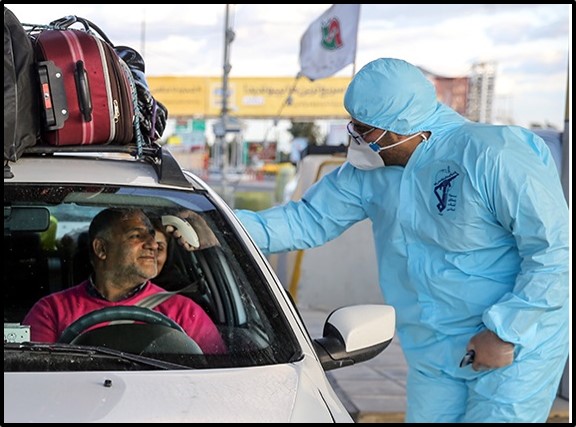
On August 3, state television revealed that one Iranian was dying from COVID-19 every seven minutes.
On August 4, Ali Asghar Mounesan, Iran’s tourism minister, said that the threat of coronavirus should not bring tourism to a complete halt. “Corona is a fact, but can the virus stop tourism? Certainly not. For us, the coronavirus is a new experience in dealing with crises that teaches tourism experts around the world how to deal with such a disaster, and thankfully governments are turning this into an opportunity for better planning,” he said.
On August 5, Alireza Salimi, the deputy on Iran’s Medical Council, warned that the development of a vaccine for COVID-19 over the next few months was unlikely. “The only thing in our power is to break the chain of transmission, plan for the continuation of the cycle of life, and minimize the death rate,” Salimi said.
On August 8, President Rouhani urged officials to find a balance between stringent restrictions and completely reopening the country. “We must follow a moderate path because it is not possible to continue with severe restrictions,” the president said. “We cannot completely shut down economic, educational and cultural activities, even if these activities cannot be the same as before coronavirus. We have no choice but to continue with our activities, but to also follow health protocols completely.”
Week 26: August 9 – 15
On August 9, President Rouhani announced that the nationwide state of emergency due to the pandemic would remain in effect until at least January 2021. “We have been in this situation for six months, and we must prepare ourselves for another six months at least,” Rouhani said. “We must find a middle way between normality and sticking to the virus restrictions.”
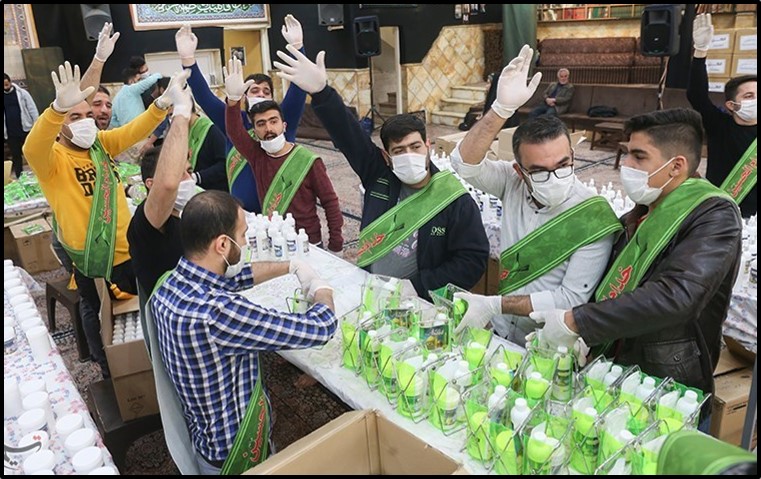
Mohammad Qasemi, the director for marketing and advertising at Iran’s Ministry of Tourism, said that Tehran was developing all-inclusive health protocols for foreign tourists. He added that new regulations would help bolster tourism in the long run by stemming the spread of the virus.
On August 10, Iran shut down Jahane Sanat, a daily newspaper, for publishing an interview with an epidemiologist who said that the government tally of COVID-19 cases and deaths only accounted for five percent of the real toll. “There was no transparent flow of information,” Mahboubfar said. “The government only provided engineered figures...over concerns about (its impact) on the election and the commemorations of the revolution anniversary.” A Health Ministry spokeswoman denied the claim and said that ministry were transparent. “The Health Ministry is not a political body and health of people is its main priority,” she added.
On August 11, the Center for Human Rights in Iran (CHRI) reported that 12 political prisoners in Evin Prison — including prominent labor leaders Esmail Abdi and Jafar Azimzadeh, human rights lawyer Amirsalar Davouudi and journalist Majid Azarpey — had tested positive for COVID-19. The outbreak in Evin's Ward 8 started in late July, according to Abdi's wife. The infected prisoners were reportedly admitted to the prison clinic. "By keeping political prisoners in overcrowded and unsanitary prisons where they are denied medical care and are not separated from ill prisoners, the Iranian authorities are condemning these individuals to COVID-19 and possible death," said Hadi Ghaemi, the executive director of CHRI.
Esmaeil Mousavi, the spokesman for Iran’s Elections Headquarters, announced that all campaigning for the second round of parliamentary elections would be conducted virtually. Mousavi said that the elections would proceed as scheduled on September 11 after they were postponed in mid-April due to the COVID-19 pandemic. He added that voting would be held in “open spaces” to stem the spread of the virus.
On August 14, Dr. Alireza Zali, the head of the Tehran Coronavirus Combat Taskforce, said that the government had made a “strategic mistake” by relying on citizens to observe social distancing guidelines. During a press conference, he criticized the government for lifting restrictions and lockdowns prematurely. “The effectiveness of the government actions will be affected if public trust is marred for any reason,” Zali added.
On August 15, President Rouhani announced that 10,000 additional hospital beds and 2,000 ICU beds would be prepared by March 2021. Rouhani also said that the government would allocate a budget to the education sector to develop better online learning platforms.
Week 27: August 16 – 22
On August 17, Iranian Minister of Tourism Ali Asghar Mounesan said that the country’s tourism industry had lost $2.85 billion due to the pandemic.
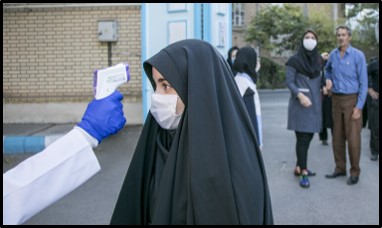
On August 18, Dr. Alireza Zali, the head of the Tehran Coronavirus Combat Taskforce, called for a two-week extension of lockdown restrictions in Tehran. “Despite an 11 percent decline in suspected Covid-19 patients visiting hospitals, Tehran Province is still on red alert,” he told reporters.
Iran said that it would wait for the approval of the World Health Organization before buying Russia’s coronavirus vaccine. “In order for the vaccine to be used, genuine and independent organizations such as the World Health Organization must comment on it and approve it, which has not happened yet,” he said.
On August 21, worshippers began rituals for the Islamic holy month of Muharram, including mourning ceremonies commemorating the killing of the Prophet Mohammed's grandson Hussein. The National Coronavirus Combat Taskforce banned annual marches, musical performances and banquets, and all indoor ceremonies. Masks and social distancing were required at outdoor venues.
On August 22, Mohammad Lahouti, the head of Iran’s Export Confederation, said that non-oil exports had declined by 39 percent due to the pandemic. “The president has announced a reduction of 10 percent in the country's economic dependence on oil, which is unprecedented,” he said. “A country, which for years relied solely on the oil, is now facing conditions that have forced it to break its dependence on oil and to move toward a non-oil economy.” U.S. sanctions, reimposed in 2018, severely curtailed Iran’s ability to sell oil.
Health Minister Namaki said that 164 health professionals had died from COVID-19.
Iran resumed flights to the Iraqi city of Basra. It was the first flight between the two countries since mid-March.
Week 28: August 23 – 29
On August 23, President Rouhani said that Iran’s economy had only shrunk by three percent during the COVID-19 pandemic. He praised the country’s resilience, adding that other countries’ economies had decreased by up to 20 percent.
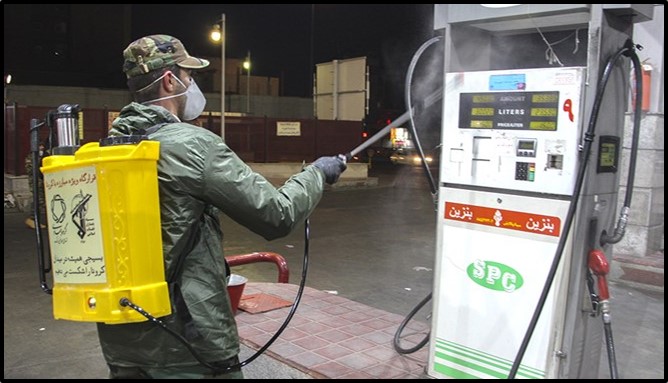
Nahid Khodakarami, a member of the Tehran city council, said that 10,200 residents of Tehran had died from coronavirus since February. He warned that Muharram mourning ceremonies could cause a third wave.
The Ministry of Health said that all foreign national infected with COVID-19 had received free medical treatment in Iran. Iran had spent nearly $95 million in medical expenses for registered foreigners since the pandemic began, according to Shahnam Arshi of the Ministry of Health.
On August 25, Health Minister Namaki warned against public complacency during the Islamic holy month of Muharram. “I am asking people not to pack bags and hopscotch around the country just because their children are done with university entrance exams,” he said. “If citizens travel again, we should expect the resurgence of the virus one week after the holidays,” Tehran Governor Anoushirvan Mohsen Bandpey added.
On August 26, Iran’s Central Taskforce for Coordinating Travel Services announced that travel and tourism would be permitted during the Muharram holiday season despite warnings from health officials.
On August 29, Health Minister Namaki blamed the “ignorance and nonchalance” of holiday travelers for putting the country’s medical workers at risk. “I wish I had the power, authority, instruments or assistance beyond begging, requesting and pleading,” he said.
Week 29: August 30 – September 5
On August 30, thousands of worshippers gathered across Iran to celebrate the holiday of Ashura, an annual day of mourning for Shiite Muslims. Indoor rituals were banned, and the government required all participants in outdoor ceremonies to wear masks and practice social distancing. President Rouhani praised the mourners for observing health protocols but expressed concern with a spike in holiday travel. “Those who have travelled during the recent holidays should not allow their non-compliance with protocols to cause a new escalation of the COVID-19 outbreak and negatively affect the hard work of the medical staff,” he said.
Deputy Health Minister Ghasem Jan-Babaei criticized travelers vacationing in Iran’s northern provinces. “Health workers are doing everything in their power to serve the people but they are exhausted because some disregard the guidelines,” he said. “More serious action must be taken against those who travel regardless of the guidance. But this is not the Health Ministry’s job and authorities in other areas must enforce the restrictions.”
President Rouhani said that Iran planned to purchase trial vaccines developed by foreign countries while still conducting its own tests and trials.
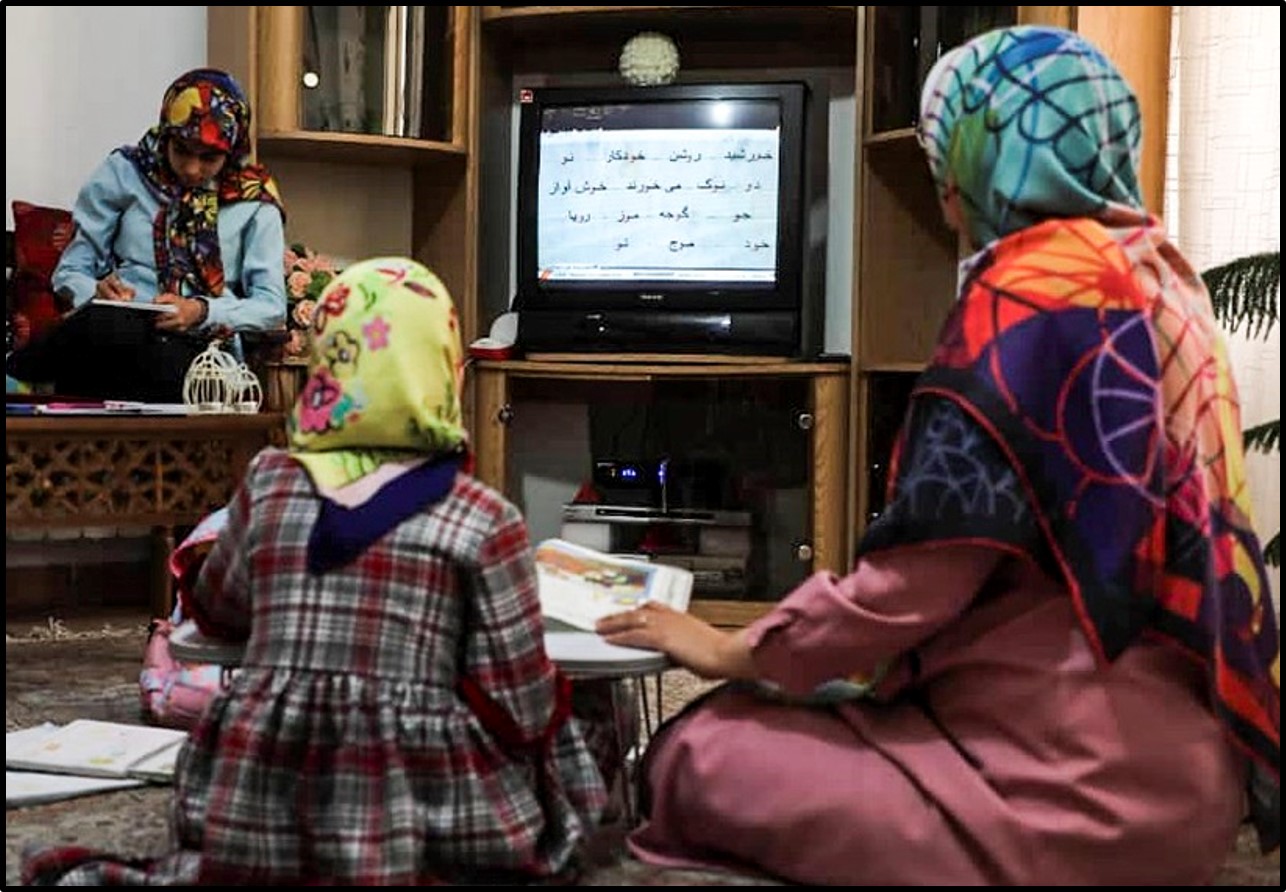
On August 31, Education Minister Mohsen Haji Mirzaei announced that schools in high-risk regions, including 13 of Iran’s 31 provinces, would not be allowed to reopen until rates of COVID-19 dropped. “Even if students do not have access to television, we will prepare learning packages and pursue education via contact with teachers,” he said. “Some 35 percent of nationwide classes, where social distancing is possible, will return to normal while following safety rules.”
The Administrative and Recruitment Affairs Organization of Iran issued a policy for reprimanding government employees who ignored health protocols at work. After the first violation, employees would receive a written warning. After a second offense, employees would be issued a citation to be documented in their employer’s records. If the employee committed a third violation, he or she would receive a one-third cut in salary for that month.
On September 3, Health Minister Namaki announced a vaccine development committee. Dr. Mohammad Mahdi Gooya, the head of the Health Ministry's Communicable Diseases Center, was tapped to lead the committee including health experts from the public and private sectors.
On September 5, schools reopened to 15 million students after seven months. Students were required to follow strict health protocols, including social distancing, masks, and temperature checks. “School is an environment. We cannot bring that environment to homes with applications [software]; the right path for education has been chosen,” President Rouhani said. “This year, teachers should educate, keep schools safe, preserve the health of children and improve learning skills.”
President Rouhani criticized the international community for not shielding Iran from U.S. sanctions during the pandemic. “Over the past months since the coronavirus arrived in our country [and] no one came to our help,” Rouhani said. If the United States “had a bit of humanity and brain,” it would have offered to “lift the sanctions for a year because of the coronavirus.”
Week 30: September 6 – September 12
On September 6, Mohammad Reza Zafarqandi, the head of Iran’s Medical Council, blasted the Ministry of Education’s decision to reopen schools. It will “no doubt lead to an increased burden on the country's medical workers,” Zafarqandi said in an open letter. “When an epidemic hit, schools are the first places that should be closed and the last to be reopened.”
On September 7, Education Minister Mohsen Haji Mirzaei stipulated that students were “not obliged” to attend in-person classes after heavy criticism from health experts. “From the beginning, we said that students' presence at schools is not mandatory,” Mirzaei said. “We said that our priority is face-to-face education, which is more appropriate for several reasons.”
Masoud Babaei, an official from the Ministry of Cooperatives, Labor, and Social Welfare, said that 850,000 Iranians had lost their jobs between February and August due to the pandemic. In the service industry, 59 percent of the workforce lost their jobs, while 31 percent of people working in the industrial sector were unemployed.
On September 11, Health Minister Namaki announced that ceremonies for Arbaeen - the Shiite religious holiday commemorating the death of Imam Hussein - would be held virtually.
On September 12, Iran said that Tehran University would start human trials to produce a COVID-19 vaccine. Animal trials were complete and preparations were being made for clinical trials, Agricultural Minister Kazem Khavazi said.
Week 31: September 13 – September 19
On September 14, Iran recorded the highest daily increase in COVID-19 fatalities since mid-August. More than 150 patients died in a single day; the overall official death toll stood at 23,313.
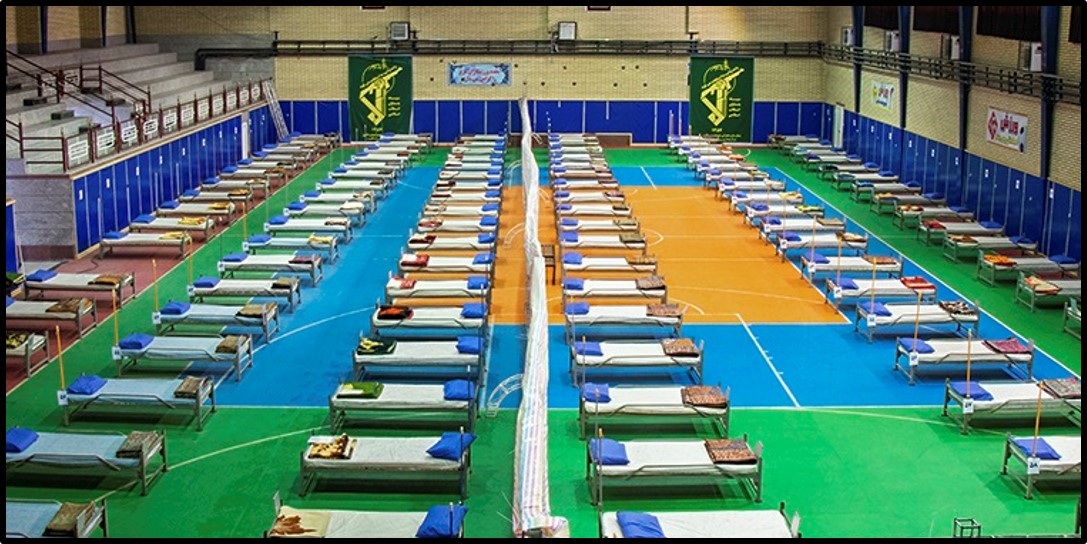
On September 17, Rouhani pledged to add 10,000 beds to hospitals across the country before March 2021. The beds would distributed to hospitals to seven provinces — in Tehran, East Azerbaijan, Esfahan, Sistan and Baluchestan, Kurdistan, Mazandaran and Gilan.
On September 18, Iran's health ministry issued a coronavirus red alert for the entire country because of a new spike in cases. “We no longer have orange and yellow,” Deputy Health Minister Harirchi said. “The entire country is red.” Harirchi warned that the death toll could reach 45,000 if the fatality rate did not decrease.
On September 18, the Tehran Stock Exchange experienced growth for the first time in five consecutive weeks.
On September 19, Iran’s health minister said that Tehran would purchase 20 million doses of a coronavirus vaccine from an Indian company. Iran had negotiated a “lower and more reasonable price” for the vaccine, he claimed.
Week 32: September 20 – September 26
On September 20, the banking sector loaned more than $1 billion to private sector businesses impacted by the coronavirus over a six-week period, the governor of Iran’s Central Bank said.
On September 22, the health ministry reported an all-time high in new infections. More than 3,700 new cases were identified in one day, which was the highest daily increase since the pandemic was first tracked in February.
On September 22, Iran cancelled public processions for the Shiite holiday of Arbaeen. The government discouraged Iranians from traveling to the holy city of Karbala for the pilgrimage. In turn, Iraq said that no Iranian pilgrims would be allowed to cross the border.
On September 23, President Rouhani blasted the United States for maintaining sanctions on Iran during COVID-19 pandemic. “My nation, the resilient people of Iran, instead of enjoying global partnership and cooperation, is grappling with the harshest sanctions in history,” he told a virtual meeting of the U.N. General Assembly.
#COVID19 is a common pain, demonstrating that our ignorance outweighs our knowledge
— Hassan Rouhani (@HassanRouhani) September 22, 2020
It reminds us of imperative of humility &humbleness, that global issues need global participation
Iranians are grappling w/ harshest sanctions in history imposed in blatant violation of UN Charter
On September 24, the official death toll from the novel coronavirus was more than 25,000, the health ministry reported.
On September 25, Iran and Russia discussed jointly developing a COVID-19 vaccine. “Iran has great potential to produce the vaccine,” said Kazem Jalali, the Iranian ambassador to Moscow.
On September 26, Rouhani authorized provincial lockdowns to stem a surge in COVID-19 cases. Governors were empowered to implement one-week lockdowns of schools, universities, mosques, cafeterias and other public places.
Week 33: September 27 – October 3
On September 29, Iran announced that coronavirus infections exceeded 450,000. The death toll reached almost 26,000.
On September 30, Rouhani praised the establishment of a joint Iranian-Danish medical and pharmaceutical center in Tehran. International cooperation during the pandemic is a " very important," he said.
On October 1, Iran was ready to work with China on joint production of a coronavirus vaccine, Rouhani said.
On October 3, Iran closed schools, libraries and mosques in Tehran for a week to control the spread of the novel coronavirus. President Rouhani said that the government would fine those who violated health protocols.
Week 34: October 4 – October 10
On October 5, Iran reported 3,902 cases of COVID-19—a new daily record—and 235 deaths.
On October 6, Deputy Health Minister Harirchi announced that all Iranians would be required to wear masks in public as of October 10. The government discussed how much to fine citizens who broke heath protocols. All flights to Turkey were suspended until November 1, the civil aviation authority announced.
On October 7, the daily death toll hit an all-time high at 239, the health ministry reported.
The US regime w/
— Iran Foreign Ministry 🇮🇷 (@IRIMFA_EN) October 7, 2020
- highest num of Covid19 cases & deaths;
- a superspreader at its head;
- a record of denial of the disease;
- & continued mismanagement of its impact,
has no standing to lecture others.
As long as sanctions r in place, your hypocritical offers sound hollow. https://t.co/hiZunDAcDM
On October 9, Iran stopped admitting non-emergency patients to hospitals due to the surge in coronavirus patients, the health ministry said. All military medical units were mobilized to set up field hospitals and mobilize support for hospitals, Rear Admiral Habibollah Sayyari said.
On October 10, Face masks became mandatory in Tehran. Violators faced fines of 500,000 rials. President Rouhani allocated $100 million to purchase rapid coronavirus test kits. He spoke with Russian President Vladimir Putin on jointly developing a COVID-19 vaccine.
Week 35: October 11 – October 17
On October 12, daily deaths from COVID-19 reached a record high of 272. Vaccine trials on human subjects would begin within weeks, the health ministry said.
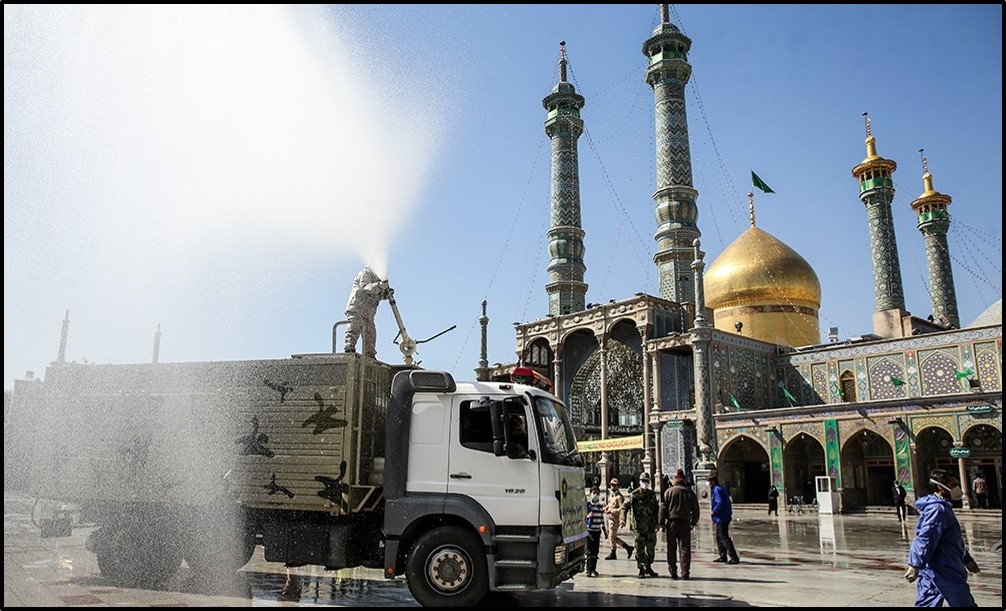
On October 13, Iran resumed gas exports to Iraqi Kurdistan. Iran and Mali cancelled a soccer match in Antalya, Turkey after several Malian players tested positive for the coronavirus. IRGC medical facilities and personnel were focused on fighting the coronavirus, Revolutionary Guards commander Hossein Salami said.
On October 14, Iran imposed a three-day travel ban on five cities: Tehran, Karaj, Mashhad, Isfahan and Orumiyeh. The ban would run from October 17 to 19 after the daily death toll rose to 279 and broke the record for the third time in a week.
On October 16, Iran Air announced an emergency return flight home for any Iranian residing in Rome after Italy recorded more than 5,000 new cases on October 9. The flight was scheduled for October 26.
On October 17, the government extended its shutdown of Tehran for a third week. Schools, mosques, restaurant and businesses remained closed until at least October 23. Iran's conventional armed forces prepared to make all military hospitals and medical centers available to coronavirus patients.
Week 36: October 18 – October 24
On October 18, The World Health Organization delivered 150 ventilators to Iran. It also donated 100 PCR machines used for testing positive cases of COVID-19.
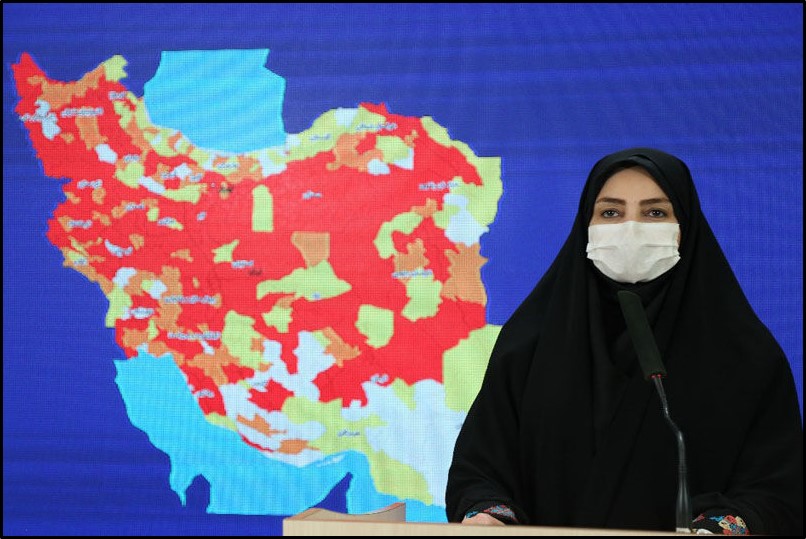
On October 19, Iran shattered its single day record with 337 deaths.
On October 20, Iran broke its single day record for daily COVID-19 cases, with 5,039 new infections.
On October 21, Iran broke its daily record for new COVID-19 cases for the second consecutive day, with 5,616 new infections.
On October 22, the Central Bank urged the International Monetary Fund (IMF) to grant Iran emergency loans to fight the pandemic. Iran had not asked the IMF for a loan since the 1960s.Tehran first requested a $5 billion loan in March, but the Trump administration blocked the funds.
On October 23, Iran reported 6,134 new coronavirus cases, another record high.
On October 24, Supreme Leader Khamenei recommended banning "unnecessary travel between cities" and "imposing strict regulations" on public transportation and public spaces.
Week 37: October 25 – October 31
On October 26, one person was dying every four minutes from COVID-19, state television reported. Partial lockdown measures went into effect in 43 cities. Nearly all private businesses, religious institutions and government buildings were told to remain closed until November 20. Half of all public sector employees were told to work remotely.
Corona's proven deadly, vicious & brutal everywhere, but it's worse in Iran as it has a cruel collaborator: US regime.
— Iran Foreign Ministry 🇮🇷 (@IRIMFA_EN) October 26, 2020
U.S. has elevated max pressure to Health Terrorism & targeted Iranian ppl w/ inhuman sanx while they're fighting the pandemic.
We'll overcome but NEVER forget. pic.twitter.com/n3c9QuIfQ7
On October 27, daily deaths reached a new record of 346, the Health Ministry reported. President Rouhani appointed his interior minister, Dr. Rahmani Fazli, to head a new COVID-19 operational center. The actual death toll might be three or four times the official tally, a senior member of Iran's medical professional organization said.
On October 28, the daily death toll exceeded 400 for the first time. One person was dying every three minutes from COVID-19, state television reported. Parliament Speaker Mohammad Baqer Qalibaf tested positive for the coronavirus, he announced on Twitter.
On October 29, new coronavirus daily cases reached an all-time high of 8,293.
On October 30, Iran exceeded 600,000 total confirmed coronavirus cases.
On October 31, the government indefinitely banned all weddings, wakes and conferences in Tehran. It also extended the lockdown of all public areas by one week.
Week 38: November 1 – November 7
On November 1, the head of Iran's Medical Council, Mohammadreza Zafarghandi, said that true death toll was "at least three times higher than the official death toll." The Council reached its figure through field surveys in hospitals and cemeteries.
On November 2, the government imposed a four-day travel ban on 25 cities. The daily death toll reached 440, another record high.
On November 3, new daily coronavirus cases hit 8,932, another record high.
On November 4, banks and tourism businesses hurt by the pandemic began receiving government loans.
On November 7, President Rouhani called for "strict observance" of health protocols. “Dealing with the coronavirus outbreak is an easy issue if health protocols are followed, but if members of the society ignore health protocols and become ill, it will be a difficult issue for the entire country," he said.
— IranGov.ir (@Iran_GOV) November 8, 2020
Week 39: November 8 – November 14
On November 9, Iran surpassed 10,000 new daily coronavirus cases. The government approved four herbal medicines for treating coronavirus symptoms. "None of these drugs are a cure for COVID-19, but they have effects to reduce the symptoms of this disease," said Kianoush Jahanpour, the spokesperson for Iran’s Food and Drug Administration.
On November 10, the government imposed a month-long nightly curfew starting at 6 p.m. on restaurants and nonessential businesses in Tehran and other large cities. More than 100,000 coronavirus tests would be carried out per day, the health ministry said.
On November 11, Iran's daily death toll reached 462, another record high.
On November 13, Tehran was considering a two-week total lockdown of the capital that would include all non-essential businesses, Iranian media reported.
On November 14, the government began human clinical trials for two potential coronavirus vaccines.
Week 40: November 15 – November 21
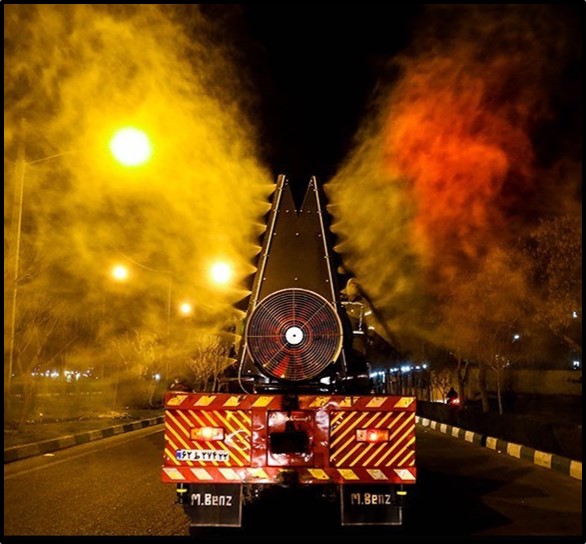
On November 15, President Rouhani announced that Iran would impose a "comprehensive lockdown" starting on November 21. Non-essential businesses would be closed and cars would not be permitted to enter or leave 100 cities. "The government has no choice but to impose new policies and restrictions at the suggestion of experts and prevent the spread of the destructive virus," he said.
On November 16, Iran's COVID-19 outbreak broke another record high, with 13,053 new infections and 486 death in a single day.
On November 17, President Rouhani pledged economic relief to businesses hurt by the lockdown measures in next year's budget, which would be submitted to parliament by December 5.
On November 18, Iran recorded another all-time high, with 13,421 new cases. More than 800,000 people had been infected since February.
On November 21, lockdowns for non-essential businesses and travel bans between major cities went into effect. Streets in Tehran remained "crowded despite the restrictions," state TV reported.
Week 41: November 22 – November 28
On November 24, the government threatened businesses that violated lockdown with fines ranging from 3 million rials ($11.50) to 15 million rials ($57.80). New cases hit another record high, with 13,721 infections within 24 hours.
On November 26, the health ministry confirmed that Iranian scientists would cooperate with Russian companies to develop a vaccine.
On November 27, daily coronavirus cases exceeded 14,000 for the first time, another all-time high.
Week 42: November 29 – December 5
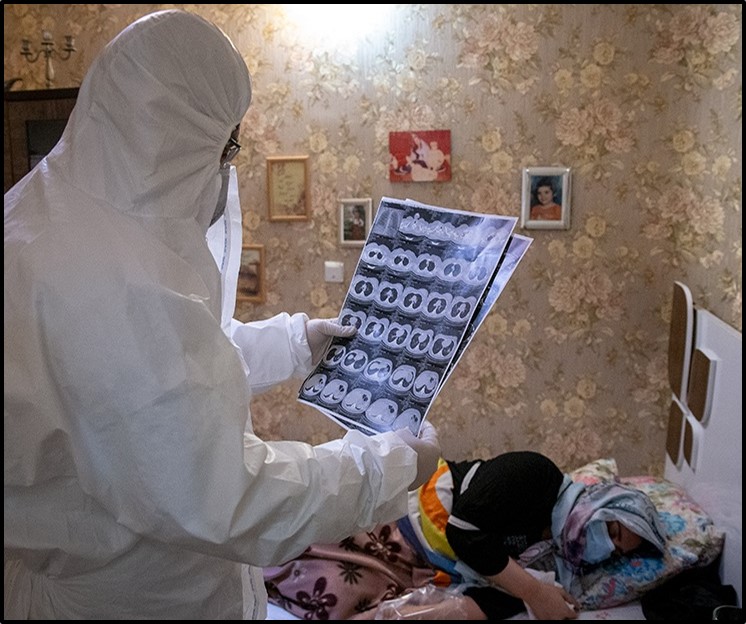
On December 1, President Rouhani pledged to support the "underprivileged" and those hit hardest by the pandemic in 2021 budget bill.
On December 2, the government said businesses in Tehran would be permitted to reopen on December 5 after a two-week lockdown. Iran would begin domestic production of a coronavirus vaccine in the spring, Health Minister Namaki said.
On December 3, Iran's total COVID-19 cases since February exceeded one million.
On December 4, the government extended lockdowns across major cities for another two weeks.
On December 5, the government unveiled a new relief package for businesses impacted by COVID-19. The measures included tax relief and postponing bank and insurance payments.
Week 43: December 6 – December 12
On December 7, the Central Bank governor claimed that U.S. financial sanctions were blocking purchase of the coronavirus vaccine by Iran.
On December 9, the government would both import and produce domestically the COVID-19 vaccine in the coming months, President Rouhani said. He claimed that U.S. financial sanctions were blocking Iran's ability to importing medicines, vaccines and medical equipment.
On December 12, deaths from coronavirus infections were down significantly, Health Minister Namaki said. "We will have a much brighter prospect in tackling the pandemic,” he told reporters.
Week 44: December 13 – December 19
On December 13, the number of cities on red alert dropped from 160 to 23, the health ministry said. The number of new infections dropped to the lowest since October.
On December 14, Iran would distribute its homegrown COVID-19 vaccine early next summer, the health ministry said.
On December 15, COVID-19 deaths in Tehran province had dropped significantly due to health protocols and lockdown measures, the provincial governor said. “Although we have not reached stable circumstances, the disease is being better managed compared to last month,” Governor Anoushiravan Mohseni-Bandpey said. He warned that easing restrictions prematurely could trigger a new rise in infections.
On December 16, Iran would issue permits to produce Remdesivir, an anti-viral drug effective in COVID-19 treatment, Health Minister Namaki said.
2021
Week 47: January 3 – January 9
On January 5, Iran had purchased 16.8 million doses of the COVID-19 vaccine through the World Health Organization’s COVAX program, the Central Bank announced. Funds were routed through a Swiss bank and were exempted from U.S. sanctions.

On January 9, the health ministry said that Iran would receive Cuba’s most advanced coronavirus vaccine. Havana would conduct last-stage clinical trials of its Soberana 2 vaccine on 50,000 Iranian volunteers. “This synergy will enable both countries to advance more rapidly in the immunization against the SARS-CoV-2 virus,” Cuba’s Finlay Vaccine Institute tweeted.
Week 48: January 10 – January 16
On January 10, four cases of the coronavirus variant from Britain were detected in Iran, health officials said. An Iranian family living in Europe had visited Iran and tested positive. The mutated virus was 70 percent more transmissible than previous variants, the government warned.
On January 11, schools in "blue" and "yellow" regions where coronavirus cases were the lowest would reopen on January 20, the Education Ministry said. The directive applied to primary and secondary schools with fewer than 50 students. Vocational schools could resume in-person classes capped at 10 or fewer students.
On January 12, President Rouhani assured Iranians that the government would have enough vaccines to meet domestic demand. “Millions of doses of vaccine have been purchased in that way that would be supplied and the vaccination will be carried out,” he said. Five new cases of the coronavirus variant from Britain were detected in Iran, the health ministry said. Ministry spokesperson Sima Sadat Lari warned that a fourth wave of COVID-19 infections was possible and urged Iranians to continue following strict health protocols.
Week 49: January 17 – January 23
On January 23, vaccines would be administered to high-risk populations within weeks, Rouhani announced. “Foreign vaccines are a necessity until local vaccines are available,” he said in televised remarks. Three domestic vaccines - Barekat, Pasteur and Razi – would not be ready until the spring or early summer.
No Iranian cities remained in the “red” zone, the health ministry said. But widespread violations of social distancing and lockdown measures continued. “There were reports from different cities of numerous cases of failure to comply with the protocols,” Alireza Raisi, the national coronavirus taskforce spokesperson, said.
Week 50: January 24 – January 30
On January 24, Health Minister Namaki recommended strict controls on travel between Iranian cities to prevent spread of the coronavirus variant from Britain. “The new virus is not restricted to Europe and can spread in any climate, even if we control all the ways,” Namaki said. A fourth wave of COVID-19 infections would inflict even greater hardship than previous waves, he warned.
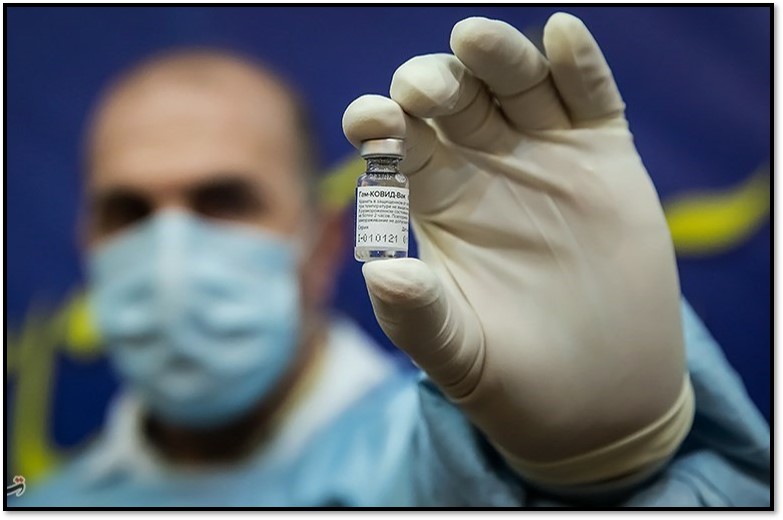
On January 26, Iran approved imports of Russia’s Sputnik V vaccine. “In the near future, we hope to be able to purchase it, as well as start joint production,” Foreign Minister Mohammad Javad Zarif said at a press conference in Moscow. The Russian vaccine was the first foreign vaccine approved for import after Khamenei banned vaccines imported from the United States and Britain on January 8. Iran would begin vaccinating high risk individuals within two weeks, government spokesperson Ali Rabiei said.
Tehran urged President Joe Biden to unfreeze Iranian assets and loosen sanctions to purchase medical and humanitarian goods. “Since [Biden’s] administration claims not to be anti-science like the previous one ... one expects it to free the transfer of Iran’s own foreign exchange resources to fight the coronavirus and for health and food, and lift banking sanctions quickly,” Rabiei said.
On January 28, the Food and Drug Administration of Iran granted emergency authorization for the Russian Sputnik V vaccine. The agency was evaluating other vaccines made in India and China for approval, a spokesperson said.
On January 29, compliance with health safety protocols in Tehran fell from 82 percent to 39 percent, Deputy Health Minister Iraj Harirchi said. The Ministry warned that a “decline in observance of health protocols could lead to a new wave of the disease,” state radio VIRI reported.
On January 30, Iran imposed a two-week quarantine on all travelers arriving from Europe. Even travelers who tested negative would be required to quarantine. Pharmaceutical companies pledged to produce between one and two million does of the homegrown vaccine, known as CovIran Barekat, by the end of March. The Iranian vaccine was effective on the U.K. variant of the virus, health ministry officials said. “Tests have shown that the blood plasma of the people who were injected with the vaccine in human trials is capable of completely defusing the mutated virus of the English corona[virus],” said Hassan Jalili, who oversees production of CovIran Barekat.
Week 51: January 31 – February 6
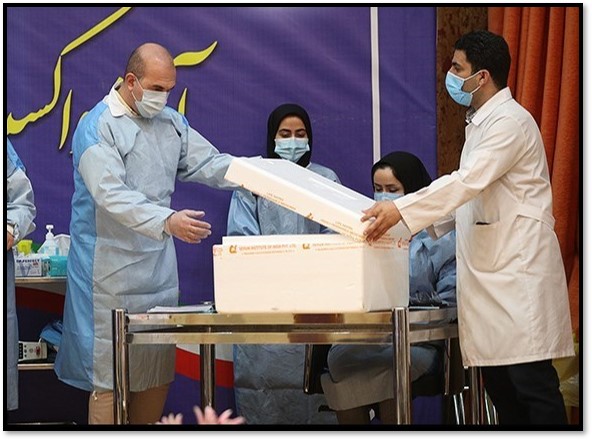
On February 1, the government said that vaccinations for the elderly, health workers, people with disabilities and war veterans would begin in spring 2021. But the government also warned that most Iranians would have to wait until February or March 2022 to be vaccinated.
On February 2, the government said that its domestic vaccine, CovIran Barekat, would be ready by late-April. It planned to produce 12 to 14 million doses each month starting in May.
On February 3, the health ministry said that Iran would receive 4.2 million doses of the AstraZeneca coronavirus vaccine in mid-February. The vaccines were secured through COVAX, the World Health Organization’s vaccine distribution program.
On February 4, Iran received 500,000 doses of the Russian Sputnik V vaccine, the first foreign coronavirus vaccine approved for domestic use. The shipments arrived at Imam Khomeini Airport from Moscow via Mahan Airlines.
On February 5, the second shipment of the Sputnik V vaccine would arrive within two weeks and a third shipment would arrive by February 28, the Iranian ambassador to Moscow said. New shipments would arrive every two weeks after that, he added.
Week 52: February 7 – February 13
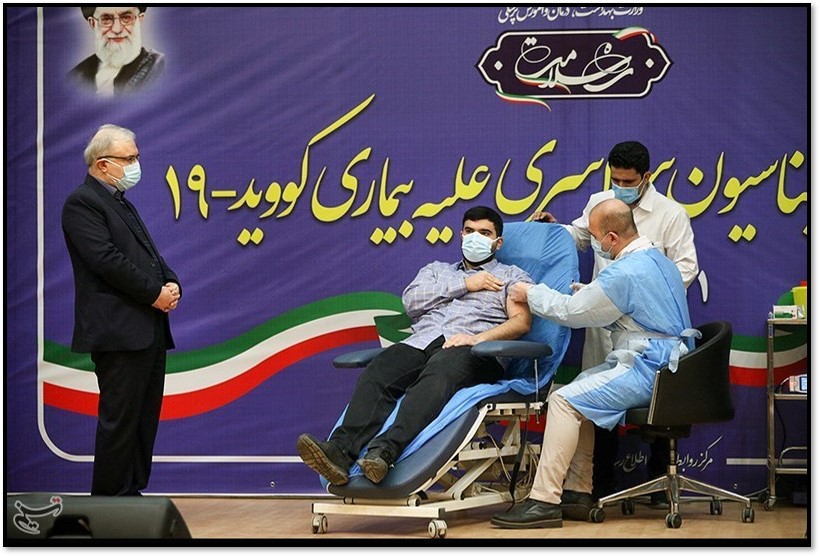
On February 7, Health Minister Namaki said that vaccinations for medical workers would begin on February 9. Doctors and nurse in intensive care units were the top priority. President Rouhani warned that achieving herd immunity would take a “long time” and told Iranians to remain vigilant. “Even after the general vaccination, since none of the vaccines is 100 percent effective, it is necessary to follow the health protocols with complete accuracy,” he said. Iran finished the first phase of human trials for CovIran Barekat, its domestically-produced vaccine. The government would test a second homegrown vaccine, Razi CovPaz, on human volunteers in the coming days.
On February 9, Iran began inoculating health care workers using Russia’s Sputnik V vaccine. Health Minister Namaki’s son was the first person injected, a move designed to boost public confidence in the vaccine. Intensive care unit staff at more than 600 hospitals were also vaccinated.
On February 11, Iran agreed to produce and export Russia's Sputnik V vaccine, Tehran's ambassador to Moscow said. An Iranian delegation visited Moscow to better understand how the Russian vaccine was manufactured.
On February 13, President Rouhani urged stricter testing and quarantine measures at the border to prevent a fourth wave of the coronavirus. The health ministry declared that nine cities -- all in Khuzestan province -- were high-risk "red" zones. “Hard days are beginning for us and you must prepare to fight the most uncontrollable mutated virus which is unfortunately infecting the country,” Health Minister Namaki said.
Week 53: February 14 – February 20
On February 17, Iran claimed that its homegrown vaccine was"100 percent" effective against the British variant of the coronavirus. The government planned to open its first domestic vaccine factory within two weeks. The factory would be able to produce three million doses of CovIran Barekat each month. The government also authorized three other coronavirus vaccines for import: one from India, one from Russia and the Oxford AstraZeneca vaccine.

More than 3,000 doctors and nurses have left Iran since the start of the pandemic, Iran's medical professional organization reported. "When physicians face social, job and welfare tensions, and job insecurity on a daily basis, these all lead them to lose their motivation," said Mohammad Jahangiri, a senior official with the Medical Council of Iran. "When we don’t create motivations and simultaneously there is a need for doctors in other countries, they leave the country."
On February 18, Iran identified 21 cases of the British coronavirus variant. The patients infected were from Tehran, Alborz, Qazvin and Khuzestan provinces. Iran's U.N. envoy called the virus the "common enemy of humanity" and urged wealthier nations to donate vaccine surpluses to poorer nations. “There is no other option but to achieve success in containing the virus,” Ambassador Majid Takht Ravanchi told the Security Council.
On February 19, the government prohibited in-person concerts and cultural events to stem the spread of a new coronavirus variant. "All the concerts can only stream online,” Deputy Health Minister Mohsen Farhadi said. The number of foreign visitors to Iran decreased by 94 percent in 2020, the tourism ministry said. More than 1.5 million jobs had been lost in the travel sector due to the coronavirus.
On February 20, Iran closed its borders with Iraq to prevent the spread of the mutated COVID-19 strain. “The main source of infection ... with the British coronavirus in Khuzestan province were travelers who came from Iraq,” Namaki said. The government closed four entry points at Kileh, Piranshahr, Chazzabeh and Shalamcheh.
Week 54: February 21 – February 27
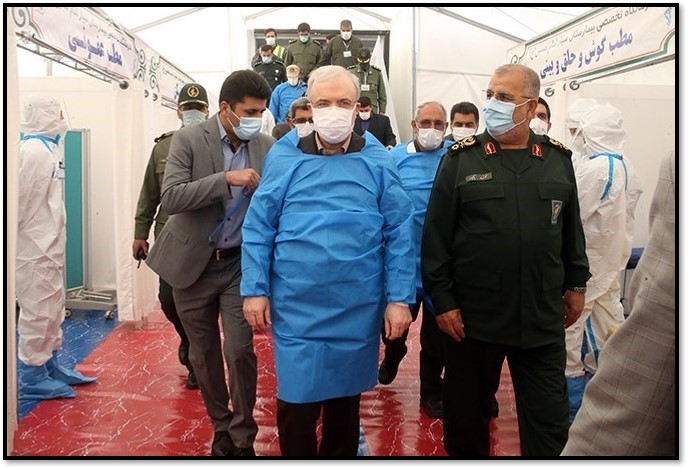
On February 21, Iran claimed that its domestically-produced vaccine was highly effective against the virus. “Preliminary results show that about 90 percent of the people who received two doses of the vaccine exhibit evidence of immunity,” Mohamad Reza Salehi, who heads clinical trials for CovIran Barekat, said.
On February 22, Tehran and Tokyo discussed using frozen Iranian financial assets in Japanese banks to purchase vaccines. The Japanese ambassador in Tehran suggested the move during a meeting with Central Bank of Iran Governor Abdonnaser Hemmati, state media reported.
On February 24, Iran detected 13 new cases of the mutated coronavirus: five in Tehran province, seven in Hormozgan province and one in West Azerbaijan province. A total of 112 patients had been infected with COVID-19 variant and eight had died, the government said. The government closed a fifth border crossing with Iraq at Mehran.
On February 25, infections among children were up 10 percent since last year, the government said. “Two age groups, those under 10 and above 70 are considered high-risk groups," Alireza Zali, head of the Coronavirus Taskforce of Tehran, said. "They need to strictly abide by health protocols.” Iran would import four million vaccine doses by late March, the health ministry said.
On February 27, President Rouhani warned that travel restrictions would remain in place through the Nowruz holidays, which will begin on March 21. The government encouraged Iranians to stay home and abide by health guidelines.
Week 55: February 28 – March 6

On February 28, Iran received 250,000 doses of China's Sinopharm vaccine, the second foreign vaccine imported by Tehran. The government called the donation a "new symbol of friendship" between Tehran and Beijing. “Cooperation in containing the coronavirus once again proved the significance of strategic relations between the two countries,” Foreign Ministry spokesperson Saeed Khatibzadeh tweeted in Mandarin.
The government banned flights from 32 countries to stem the spread of the mutated coronavirus. The list included countries in Africa, South America and Central America that the health ministry had deemed "high risk."
On March 3, the government pledged that it would vaccinate Iranians aged 65 and older by July at the latest. The next priority group after the elderly were Iranians between the ages of 16 and 64 with underlying conditions.
On March 4, Iran received a third shipment of Sputnik V vaccines from Russia. Some 200,000 doses arrived at Imam Khomeini International Airport in Tehran.
On March 5, the government said that one million doses obtained through the WHO’s COVAX program would arrive between March 18 and March 28. Iranians older than 80 and those suffering from underlying illnesses would be prioritized for vaccination.
On March 6, President Rouhani banned travel during Nowruz to all red- or orange-zone cities and urged Iranians to avoid travel in general during the Persian New Year. “The start of the vaccination drive in the country should not lead to people considering the situation as normal,” he said at a meeting of the National Coronavirus Task Force. Rouhani also said that social distancing measures should continue “for at least one year from now due to the many mutations of the virus.”
Week 56: March 7 – March 13
On March 7, the health ministry said that South Korea would import 3.1 million doses of the AstraZeneca vaccine.
On March 9, inoculations using the domestically produced CovIran Barekat vaccine would begin in May, the chairman of Setad said. He assured the public that there was a sufficient supply of vaccines for the next two-and-a-half months.
On March 10, Iran's Food and Drug Administration issued a permit allowing emergency use of China's Sinopharm vaccine. China sent 250,000 doses of the vaccine to Iran on February 28.
On March 11, Iran received 100,000 doses of Cuba's Soberana 2 vaccine, Fars News Agency reported. Tehran had previously allowed Cuba to conduct last-stage clinical trials on 50,000 Iranian volunteers in exchange for doses of the vaccine.
On March 13, Rouhani urged Iranians to take special precautions during Nowruz this year. "Considering that we are still dealing with this disease and have not yet reached a reassuring and stable point, this year we must hold the visits with masks and without shaking hands," he said.
Week 57: March 14 – March 20
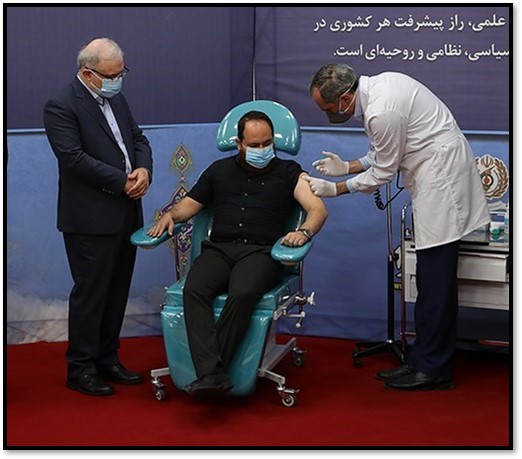
On March 15, the government began mass production of the CovIran Barekat vaccine. Its goal was to initially produce 3 million doses a month and then to scale up to 12 to 15 million doses per month by June, the chairman of Setad said.
On March 16, Iran initiated human trials for a third domestically-produced vaccine, Fakhravac. The vaccine was named after assassinated nuclear scientist Mohsen Fakhrizadeh and developed by his former employer, the Organization of Defensive Innovation and Research. Hamed Fakhrizadeh, Mohsen's son, received the first dose at at an unveiling ceremony in Tehran. The government planned to test the vaccine on 20,000 volunteers.
On March 18, the government extended its ban on flights to and from Britain until May 1. Iran's Civil Aviation Organization had first suspended flights to Britain on December 22, 2020, to prevent the spread of the mutated strain of the coroanvirus. Flights to and from Iraq remained suspended until the end of March.
On March 19, the government assured Iranians that no government official had skipped the line to be vaccinated. President Rouhani's chief of staff, Mahmoud Vaezi, said that only those in priority groups - such as healthcare workers, the elderly and those with underlying medical conditions - had received the vaccine.
Week 58: March 21 – March 27
On March 25, Iran would receive 100,000 additional doses of the Sputnik V vaccine, Tehran's ambassador in Moscow said. Russia had already sent Iran more than 400,000 doses of the vaccine since February 4.
On March 27, Iran was in talks to purchase 10 million doses of the Sputnik V vaccine, Tehran's ambassador to Moscow said. Russia had previously agreed to sell one million doses of its vaccine to Iran.
China pledged to help Iran fight the coronavirus pandemic with additional medical equipment and medicine. "We will provide more COVID-19 vaccine to Iran, and Iran is our priority in this regard," Chinese Foreign Minister Wang Yi said in Tehran.
Week 59: March 28 – April 3
On March 30, Iran said that it would begin mass production of the Fakhra vaccine by late May. Mass production of CovIran Barekat, Iran's first domestically developed vaccine, began on March 15.
Health officials warned that widespread travel during Nowruz may have triggered “A fourth coronavirus wave has definitely begun in many parts of the west and center of the country and is advancing towards the east,” a Health Ministry spokeswoman said.
On March 31, the health ministry declared that it had vaccinated 80 percent of health care workers who dealt with coronavirus patients.
On April 3, President Rouhani warned that the fourth wave of the pandemic had begun in two provinces. "If we do not observe health protocols, this wave will enter other provinces as well," he said at a meeting of the National Coronavirus Task Force. Rouhani promised that the government would prioritize developing and importing vaccines but urged Iranians to quarantine themselves at the first sign of illness. “It is not acceptable for someone who is diagnosed with COVID-19 to go to work or attend meetings, or worse, to travel," he said.
The government restricted travel to and from Turkey to help curb the spread of the mutated coronavirus. All land and air travel was suspended for a week. Iranian citizens living in Turkey could return home if they tested negative.
Week 60: April 4 – April 10
On April 4, the Health Ministry classified Tehran a "red-zone," high-risk city as COVID-19 infections surged in the capital. Hospitalizations increased 37 percent compared to the previous week. Local officials called for tightened health and safety regulations to prevent the further spread of the virus. "What is evident to us for now is that the fourth wave of the pandemic has hit Tehran,” Nader Tavakkoli, an official with the provincial coronavirus task force, said.
officials say Iran is seeing a new wave of covid outbreak, in the absence of mass vaccinations & inefficient restrix that are not properly enforced.
— Hadi Nili (@HadiNili) April 7, 2021
17k+ new cases & 174 deaths just in a day; per OFFICIAL numbers.
(map: red & orange are "very high risk" & "high risk" territories) pic.twitter.com/JzCjrHbDRA
On April 5, more than 700,000 doses of the Oxford/AstraZeneca vaccine - purchased through COVAX - arrived in Iran. The vaccines were produced in South Korea and transported via the Netherlands to comply with the supreme leader's ban on vaccine imports from Britain.
IranAir, the national airliner, announced a special flight on April 11 to bring Iranians living in Britain back home. All passengers older than eight years of age would need to present negative COVID-19 tests before boarding the flight.
On April 6, Iran extended travel restrictions to Iraq for two additional weeks.
On April 7, Iran broke its record for daily infections as new cases reached nearly 21,000. All provincial capitals were categorized as "red zones" with the highest risk of infection. Many had been classified as "blue" or in the lowest risk category during Nowruz, Tasnim News Agency reported. The Health Ministry announced that 85 percent of the country was in a "red" or "orange" zone.
On April 10, the government ordered a 10-day lockdown in 23 of Iran's 31 provinces. All businesses, schools, theater and sports facilities were forced to shutdown. President Rouhani blamed the mutated COVID-19 variant originating in Britain for the spike in cases. The president threatened strict punishments for Iranians who broke health and safety protocols. "Violation of quarantine by infected people is very dangerous and must be dealt with legally," he said.
Week 61: April 11 – April 17
On April 11, the government extended the ban on travel to Iraq until April 20. Only Iranians with education, healthcare, investment or business visas could cross the border.
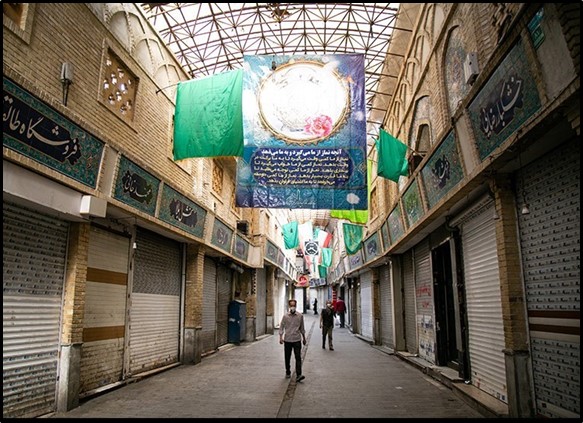
On April 13, Iran would begin mass producing the CovIran Barekat vaccine on April 21, the chairman of Setad said. Iran would prioritize domestic vaccinations before exporting doses abroad, he added.
On April 15, Iran will purchase 60 million doses of Russia's Sputnik V vaccine, the Iranian ambassador to Moscow said. The doses are scheduled to arrive in Iran between May and November, the state-run IRNA news agency reported. Iran received another 400,000 doses of the Sinopharm vaccine donated by the Red Cross Society of China, the government said.
On April 16, Health Minister Namaki said that Iran had administered 500,000 vaccines so far and would administer a total of 1.3 million doses by April 22.
On April 17, President Rouhani urged that Iranians follow "strict, full observance of all health protocols" including hand washing, mask wearing, social distancing and avoiding travel. He pledged that the government would roll out its domestic version of the vaccine by the summer. "The government has done everything in its power to prepare the domestic vaccine sooner...because it is important for us to stand on our own two feet," Rouhani said.
Week 62: April 18 – April 24
On April 18, Iran reported its highest single-day death toll since November as new COVID-19 fatalities surpassed 400. Cuba received approval to begin the third phase of vaccine clinical trials in Iran. Some 50,000 Iranians between the ages of 18 and 80 would receive the Soberana 2 vaccine, Tasnim News Agency reported.

On April 20, the Central Bank said that it had set aside $178 million to purchase vaccines through COVAX. Iran cancelled its annual Qods Day rallies scheduled for May 7, the last Friday of Ramadan, due to the outbreak of the fourth coronavirus wave. The annual event was started by the Islamic Republic in 1979 and is typically marked by government-sponsored protests against Israel. This was the second year in a row that Iran was forced to cancel street rallies for Qods Day.
On April 21, Iran purchased COVID-19 vaccines from South Korea using $30 million frozen in Korean banks, IRNA reported. In February, South Korea reached a deal with Iran to unlock $7 billion worth of Iranian assets held by two South Korean Banks - Industrial Bank of Korea and Woori Bank. Seoul agreed to use a portion of the frozen assets to pay Iran's United Nations debts and to facilitate trade of medical and humanitarian goods. The funds had been frozen since 2019 after the Trump administration sanctioned Iran's oil sector.
Air travel between Iran and Turkey had decreased by 95 percent in April, Iran's civil aviation organization said. Tehran restricted tourism to Turkey starting on April 3 to mitigate the spread of the fourth wave of the coronavirus.
On April 22, the daily death toll spiked to 453, nearly as high as during the third wave of the pandemic in November. Hospital admissions in Tehran surged, the Associated Press reported. All wards at Shohadaye Tajrish Hospital were reserved for COVID-19 patients, and Imam Khomeini Hospital turned away patients without positive COVID-19 tests. The Behesht-e Zahra cemetery - Tehran's main burial site - buried than 350 bodies in a single day, 150 of which had died from the coronavirus. Iran received 100,000 additional doses of the Sputnik V vaccine, its sixth shipment from Russia since February.
Week 63: April 25 – May 1

On April 25, Iran suspended all flights to and from India and Pakistan over concerns about rising COVID-19 cases. “Now we face a new threat that is the Indian virus, which is worse than the English, Brazilian and South African ones,” President Rouhani said. India was averaging more than 300,000 new cases per day the previous week, more than anywhere else in the world.
On April 27, the government began the second phase of its vaccination campaign. Iranians over the age of 65 and those with underlying health conditions were eligible to receive the vaccine. Iran detected three cases of the South African variant of the coronavirus, the Health Ministry reported.
On April 29, Afghanistan barred entry from Iran through the Islam Qala border but allowed cross-border trade to continue. "This precautionary measure has been taken by the Iranian government due to the increase in the number of coronavirus cases and deaths [in Iran],” the governor of Afghanistan's Herat province said.
On May 1, President Rouhani said that vaccinations of the elderly and those with underlying medical conditions should be completed in two months. "We hope that if the domestic vaccines are provided in the time announced previously, we will be able to see better conditions in business and educational issues in the second half of this year," he said at a meeting of the National Coronavirus Task Force.
Week 64: May 2 – May 8
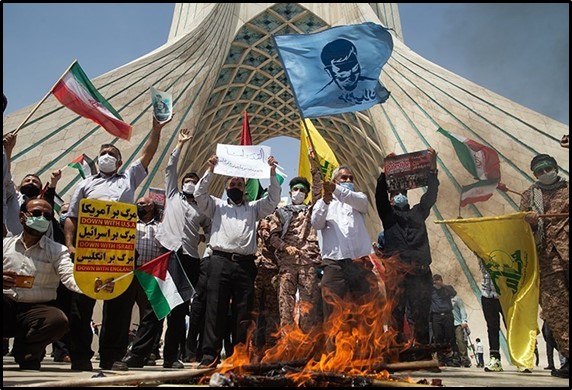
On May 2, Pakistan announced it would temporarily close border crossings with Iran for everyone except Pakistani nationals. The restrictions would go into effect on May 4 and would last until May 20. Iran said that it would pay Russia for COVID-19 vaccine shipments via Iraq. Baghdad would sent funds used to purchase Iranian natural gas and electricity to Russia.
On May 4, Tehran's Food and Drug Administration said that doses of the Sputnik V vaccine produced within Iran would be rolled out within two months, TASS reported.
On May 5, Iran finished the first phase of human trials for its "Fakhra" coronavirus vaccine.
On May 8, the government banned traveling during Eid al Fitr, the religious holiday marking the end of Ramadan. All travel between cities would be prohibited between 2 pm on May 11 and noon on May 15. President Rouhani said that Iran had passed the peak of the fourth wave of the pandemic. “Despite a rise in the number of infections during this surge, the death tally during the fourth wave was fortunately the same as that in the third surge," he said.
Week 65: May 9 – May 15
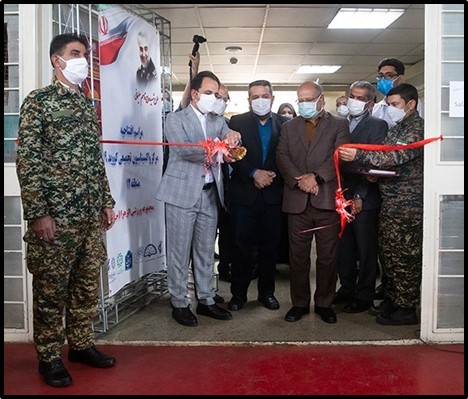
On May 9, President Rouhani set a goal of vaccinating 13 million people, approximately 15 percent of Iran's total population, by July 22. Vaccinations would cover those in the highest-risk group, the president told his cabinet. Iran began vaccinating those over the age of 65 and individuals with underlying health conditions on April 27. "Time should not be lost to save lives and the country's needs should be met by importing vaccines," he said.
On May 10, the Health Ministry announced that Iran would receive 10 million vaccine doses by early June. The government has imported 3.2 million doses of the vaccine from Russia, India, South Korea and China so far.
On May 11, Iran launched mass production of the domestically-produced CovIran Barekat vaccine. The Health Ministry received 300,000 doses from a factory constructed by Setad.
On May 12, Iran resumed flights between its port city of Bandar Abbas and Dubai in the United Arab Emirates. All passengers were required to have tested negative for COVID-19 before boarding the flight.
On May 13, an hardline lawmaker accused the government of losing 200,000 vaccines. Mohsen Dehnavi, a former cancer researcher who won a seat in 2020, said that the health ministry had left a request for the total number of vaccine doses "unanswered." The government denied the charges. "No dose has been or will be unaccounted for," a Food and Drug Administration spokesperson responded on Twitter.
On May 15, President Rouhani declared that no senior government officials had received the COVID-19 vaccine ahead of the general population. "I honestly say that I have not been vaccinated yet because it is not my turn, and I do not know any high-level official in the country that has taken the vaccine except within the framework of the national vaccination document," he said at a weekly meeting of the National Coronavirus Task Force.
Week 66: May 16 – May 22
On May 16, Iran received 1.45 million doses of the AstraZeneca vaccine from the World Health Organization. The government said that it would spend 4 trillion rials ($17.5 million) to import 10 million doses China's Sinopharm vaccine. Health Minister Namaki set a target of vaccinating 13 to 14 million Iranians by the end of June, nearly a full month ahead of the timetable set by President Rouhani.
On May 17, Mir Hossein Mousavi and his wife Zahra Rahnavard - the leaders of the opposition Green Movement - were vaccinated. The pair have been living under house arrest since 2011. Both were older than 75 and were eligible to receive the vaccine under the government's rollout plan.
On May 22, the head of Iran's transportation union warned that at least 15,000 couriers and pickup drivers had lost their jobs due to the pandemic. The number equaled between 50 and 60 percent of drivers working in the transportation sector.
Week 67: May 23 – May 29
Iran stands with Africa, inspired by its triumph against domination.
— Javad Zarif (@JZarif) May 25, 2021
As COVID-19 continues to ravage the world, we're again joined in the fight against apartheid—this time #VaccineApartheid
Iran will always be reliable partner to all African friends.
Congrats on #AfricaDay2021
On May 23, the government said that the fourth wave of the coronavirus had passed and that deaths would decrease in the coming weeks. The National Coronavirus Task Force recommended changes to voting to stem the spread of the coronavirus during Iran's presidential election, scheduled for June 18. “There is no need for using stamps and fingerprinting on the election day,” Alireza Raisi, the taskforce spokesperson, said. Voting should take place in open spaces rather than indoors, and infected patients should be offered mobile ballot boxes rather than voting in person, Raisi added.
On May 26, Iran administered the second dose of the vaccine to individuals with autism. The Health Ministry and the Iran Autism Association began vaccinations for autistic individuals in April.
On May 28, the government said that human trials of CovIran Barekat, Iran's first domestically-produced vaccine, would finish in late June. Iran began the second phase of human trials for its second domestically-produced vaccine - Razi CovPars. The vaccine was administered to 500 people. Only mild side effects, such as headaches and mild fevers, were reported.
On May 29, Tehran and Baghdad agreed to use Iranian funds frozen in Iraqi banks to purchase COVID-19 vaccines. The Trade Bank of Iraq would wire $125 million to a Swiss bank to purchase 16 million doses from COVAX, Iran's minister of energy said. Billions of dollars in Iranian oil revenue were frozen in accounts abroad after the United States reimposed sanctions on Iran's oil sector in 2018.
President Rouhani said domestically-produced vaccines could accelerate the timetable for Iran's inoculation campaign. "If enough vaccines are produced domestically and we buy the required vaccine at the same time, we can start the public vaccination in August and end it until December," he told the National Coronavirus Task Force.
Week 68: May 30 – June 5
On May 31, Iran's Food and Drug Administration said that it would issue authorization for two domestically produced vaccines "over the next few days." Both vaccines - CovIran Barekat and Soberana-02 (jointly developed by Iran and Cuba) - had yet to complete clinical trials. But both vaccines met "acceptable" safety and efficacy standards, agency spokesperson Kianoush Jahanpour said. "We cannot announce the exact efficacy rate before trials conclude but both figures are somewhere between 80 to 90 percent," he said.
On June 2, the Iranian embassy in Moscow received 100,000 more doses of the Sputnik V vaccine and would ship them to Tehran by June 3. Since February, Iran has imported 820,000 doses of the Sputnik V vaccine from Russia.
Week 69: June 6 – June 12
On June 7, Ali Akbar Mohtashamipour, a former member of parliament, died from the coronavirus. He passed away in a hospital in northern Tehran, state-run IRNA reported. Mohtashamipour previously served as ambassador to Syria from 1982 to 1986 and helped establish Hezbollah, a Shiite Islamist militia, in Lebanon. In Parliament, he represented Tehran from 1990 to 1992 and from 2000 to 2004 as a hardliner. But he later joined the reformist faction and supported the opposition Green Movement, which disputed the reelection of President Mahmoud Ahmadinejad in 2009.
Related Material: One Year of COVID: Infected Officials
On June 8, the government approved new financial assistance to help businesses affected by the coronavirus, the Tehran Times reported. The package included tax waivers and deferred loan payments. The Iranian embassy in France requested that the government lift the ban on flights from Paris to Tehran. The embassy cited declining infection rates in France.
On June 9, Russia delivered 100,000 more vaccine doses to the Iranian Embassy in Moscow. The vaccines would be transported to Tehran on a Mahan Air flight by June 10. Since February, Iran has imported 900,000 doses of the Sputnik V vaccine from Russia.
Iran initiated the second phase of human trials for its Fakhra vaccine, a domestically-produced inoculation developed by the Ministry of Defense. Some 500 volunteers would receive the vaccine.
Iran's Tourism Ministry said that it had reached an initial agreement with the Foreign Ministry, Health Ministry and Interior Ministry to issue tourist visas by mid-July. "The issuance of tourist visas will resume after the final preparation and approval of travel regulations and protocols," the deputy tourism minister said.
On June 10, some 8,000 volunteers received the first dose of the CovIran Barekat vaccine as part of the third phase of human trials.
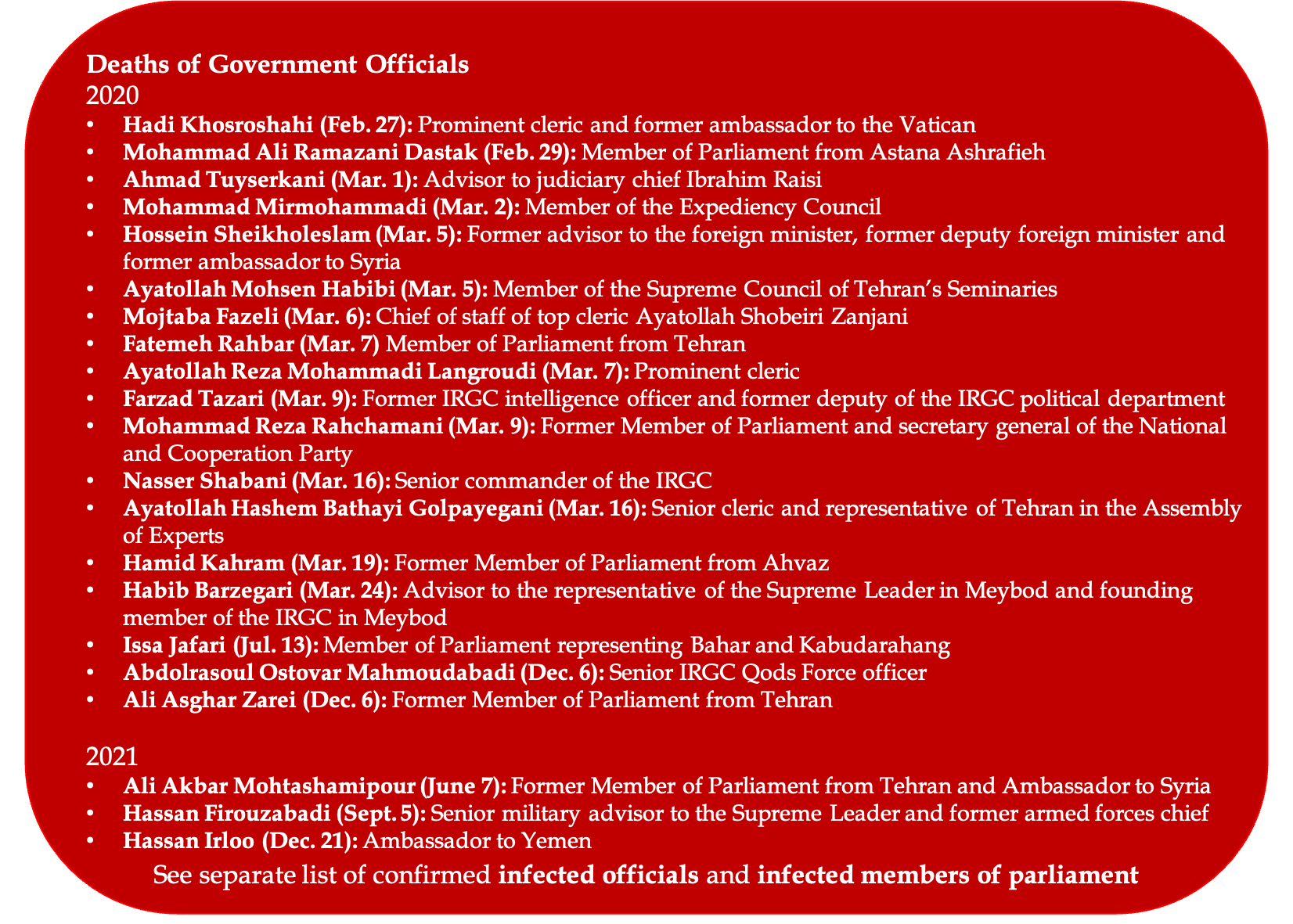
Week 70: June 13 – June 19
On June 14, Iran approved emergency use of CovIran Barekat, its first domestically developed vaccine. Health Minister Namaki said that a permit for the second vaccine, Razi CovPars, would be issued the following week. "The entire target population of Iran will be vaccinated by the end of coming fall,” he said.
On June 16, Al Jazeera reported on how the coronavirus had affected the presidential election. The government limited indoor gatherings to 15-30 people and mandated that large rallies could only be held outdoors. Election authorities increased the number of voting booths and placed them outdoors for Friday's vote.
Week 71: June 20 – June 26
On June 20, the Soberana 2 vaccine - which Iran is helping Cuba to test and produce - demonstrated a 62 percent efficacy rate with two of its three doses. Cuba expected an even higher efficacy rate in test subjects who receive the third shot, said the director of Cuba's state-run Finlay Vaccine Institute.
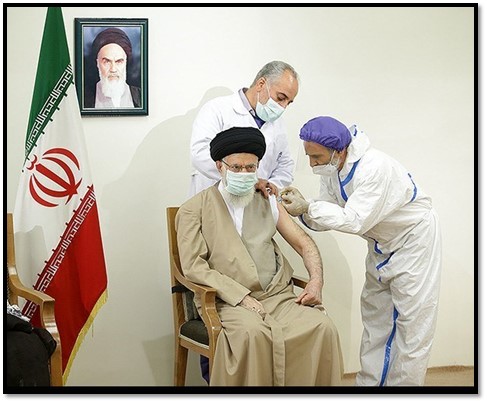
On June 22, President-elect Ebrahim Raisi pledged to procure more vaccinations once in office. "The quickest general vaccination...will be among our immediate programs from the first day of the government," he said in a speech in Mashhad. Raisi said that his government would procure more domestically-produced vaccines as well as "if necessary, those produced abroad."
On June 25, Supreme Leader Khamenei received his first shot of the domestically-produced CovIran Barekat vaccine. The supreme leader's office said that he had two conditions for being vaccinated: he did not want to receive his shot out of turn, and he would receive a domestically-made vaccine. "I did not want to use non-Iranian vaccines, so I said I would wait for the Iranian vaccine," Khamenei, who is 82, said. Iranians over the age of 80 became eligible for vaccination in March.
Khamenei had previously banned all vaccine imports from the United States and Britain, which produced the first viable vaccines. The supreme leader added that using foreign vaccines from Russia and China was "not a problem" but urged people to "respect the Iranian vaccine and thank all the young scientists who worked hard and actively in the production."
On June 27, the Revolutionary Guards unveiled the Noura vaccine, the second vaccine affiliated with the Iranian military. The vaccine was developed by Baqiyatallah University of Medical Sciences, a public university that is the "primary medical institution" for the Revolutionary Guards, according to the U.S. Treasury. Lab tests on mice, rabbits and monkeys were successful, and human clinical trials would begin immediately, state-run IRNA reported.
Week 72: June 27 – July 3
On June 30, a second Iranian vaccine – PastuCovac/Soberana 2 – was approved for emergency use, the health ministry said. The vaccine, codeveloped by Cuba and Iran, was 62 percent effective against new COVID-19 variants, the Tehran Times reported.
On July 1, President Rouhani urged Iranians to fully comply with health protocols to avoid a fifth wave of the coronavirus. He warned that failure to do so would require the government to "impose severe restrictions again." The president added that "in no way" should foreign nationals infected with the coronavirus be allowed to enter Iran.
On July 2, the government banned entry for travelers from 12 countries to prevent the spread of the coronavirus and its more infectious delta variant. The affected countries were Botswana, Brazil, Eswatini, India, Lesotho, Malawi, Mozambique, Nepal, South Africa, Uruguay, Zambia and Zimbabwe. The travel ban would go into effect on July 4.
On July 3, President Rouhani warned that the COVID delta variant was spreading throughout Iran, particularly in the southern provinces. More than 90 counties were classified as "red" or "very high-risk" zones. "If the health protocols in these areas are not followed, the number of red cities in the country will increase," the president told the National Coronavirus Task Force.
Rouhani attributed the rise in cases to public gatherings during presidential and local elections on June 18. "Despite warnings in recent weeks, during the elections, especially in the council elections, the measures taken were not in line with health protocols," he said. Rouhani added that all Iranians had to follow public health guidelines through the end of the year, "whether people have been vaccinated or not."
Week 73: July 4 – July 10
#COVID19 #Iran:
— Slovenia in Iran (@sloiniran) July 4, 2021
The number of #COVID19 cases is increasing again in 🇮🇷. Provinces, predominantly in the SE and SW are classified as high risk and are red-coded (including #Tehran) as the more contagious Delta virus variant spreads rapidly across the country. pic.twitter.com/ZMwYkGeFcG
On July 4, the government banned travel between cities with high COVID-19 infection rates and reimposed a lockdown of all non-essential businesses in 275 cities, including Tehran. The lockdown affected "all public parks, restaurants, dessert shops, beauty salons, malls and bookstores" in cities classified as "red" or "orange," the Associated Press reported. New coronavirus infections rose 13.2 percent over the previous week, a health ministry spokesperson said.
On July 5, an ethnic Baluch lawmaker accused Afghan migrants of bringing the delta coronavirus variant to Iran, the Tehran Times reported. "In the wake of rising violence in Afghanistan, the number of migrants to Sistan and Baluchistan (province) has increased," parliamentarian Esmail Hossein-Zehi said. "Unfortunately, a majority of the people enter the country without observing health protocols."
On July 7, the intelligence ministry said that it had disbanded a vaccine smuggling network and arrested its members. The network had illegally purchased, sold and distributed foreign vaccines, including Sinopharm, AstraZeneca and Pfizer, state-run IRNA reported.
On July 8, a lawmaker warned that domestic vaccine production would not be sufficient for Iran's entire population. "Three million doses of [CovIran] Barekat vaccine and about one and a half million doses of Pasteur vaccine per month is not a significant number," said Jalil Mirmohammadi Meibodi, who sits on the parliamentary health commission. He advised the government to increase vaccine imports from abroad. "We need to vaccinate 60 million people, so we need 120 million doses of vaccine at present."
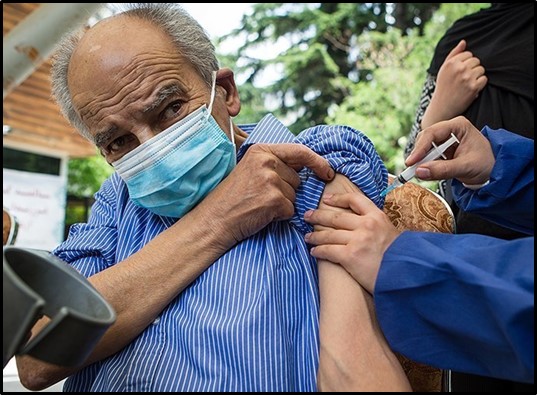
Iranian officials rejected media claims that its domestic vaccine production had been sabotaged by the United States. "The news of U.S. sabotage is not true... the production line of CovIran Barakat is operating with full capacity," Shifapharmed Industrial Group, a state-funded biotechnical group involved in manufacturing vaccines. Mohammad Marandi, a hardline media pundit, had reportedly claimed that COVID-19 vaccines had "been delayed due to an American hostile act," the Tehran Times reported in a tweet. Marandi later said that he had been misquoted and the Tehran Times deleted the tweet.
On July 10, the health ministry said that Iran would import six million more coronavirus vaccine doses by July 23. The vaccines would come from "China, Norway and Japan" as well as "other official sources," a health ministry official said.
President Rouhani warned that "despite all efforts" the COVID-19 delta variant had "penetrated deep" into Iran. "The situation is more unfavorable than in previous weeks," he told the National Coronavirus Task Force. Rouhani said that only 66 percent of people were complying with health protocols and that 85 percent compliance was required to get the virus under control. "We ask people to follow the protocols so that we can get through these difficult conditions."
Week 74: July 11 – July 17
On July 11, Iran had imposed flight restrictions on flights to 39 countries, the civil aviation authority said. Iranians could not enter those countries without presenting a negative COVID-19 test before and after arrival.
Thousands of Iranians have traveled to Armenia to get vaccinated, The New York Times reported. Tickets between the two capitals were sold out through late August. Videos on social media showed lines of cars at the border, some waiting 13 hours to cross.
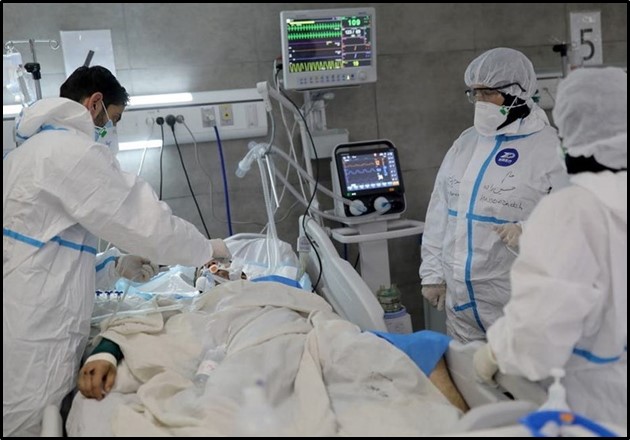
On July 12, the European Union donated $17.7 million (15 million euros) to Iran to help with COVID-19 relief efforts and hosting of Afghan refugees. The funds will go to humanitarian organizations, as well as provide Iran with "urgent medical equipment," the European Commission said in a statement.
As of July 13, some 425 taxi drivers have died from the coronavirus, Iran International reported. One taxi driver estimated that 40 to 50 drivers in Tehran died from COVID-19 each month in 2021. The Japanese government pledged that it would donate 2.9 million vaccine doses to Iran through the World Health Organization's COVAX program.
As of July 14, Iran had imported 9.4 million vaccine doses from abroad since February, the Tehran Times reported. The government received 2.1 million vaccines via the World Health Organization's COVAX program, one million from Russia and one million from China. The rest came from India, Italy and South Korea.
On July 17, Rouhani said that more than seven million doses of the vaccine had been injected since February. "We will live up to our promise of vaccination by the end of this government’s term of office," he told the National Coronavirus Task Force.
The president implored more Iranians to follow public health guideline to avoid contracting the Delta variant. "On average, 48 percent of the protocols are followed in the country, which is very low," he said. "People should know that vaccination must not cause them to ignore health protocols," he added.
Week 75: July 18 – July 24
On July 18, Setad, the state-owned foundation responsible for producing CovIran Barekat, said that it had enough raw material for 100 million doses of the vaccine. "The production technology for this Iranian coronavirus vaccine is fully indigenous, and we need no country in the processing of the jab," a Setad spokesman said. The supervisor of clinical trials for CovIran Barekat confirmed that the vaccine was effective against the Delta variant.
On July 19, Iran imposed a week-long lockdown of Tehran to deal with the surge in the COVID-19 Delta variant. Most non-essential businesses were already closed, but the new order expanded the lockdown to include all bazaars, markets and government buildings, the Associated Press reported.
More than 8,500 Iranians visited Armenia in June, many for vaccines, Reuters reported. "Demand for vaccines has created an opportunity for our travel agencies which I encourage them to take," said the deputy head of Armenia's tourism committee. All foreigners had to wait at least 10 days before becoming eligible for the AstraZeneca vaccine.
On July 20, Iran reached an all-time high of new COVID-19 infections with 27,444 new cases, the health ministry reported. The previous peak was 25,582 on April 14. New deaths were at 250, still lower than the average death rate during the third and fourth waves of the pandemic in fall 2020 and spring 2021 respectively.
On July 22, An Iranian diplomat said that Tehran would import 2.2 million more vaccine doses from China, as well as an additional one million doses from Japan. Iran had imported a total of 85.1 million doses from China, state-run IRNA news agency reported. The government expected to receive nine million more doses from Japan.
Week 76: July 25 – July 31
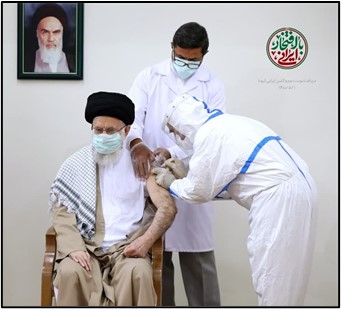
On July 23, Khamenei received his second dose of the CovIran Barekat vaccine. The supreme leader blamed delays in the vaccination campaign on foreign suppliers. “In some cases, there was a disruption in the issue of distributing the vaccine among people, which, of course, was mainly due to the unfulfilled promises of those who vowed to sell the vaccine to us," he said.
The first shipment of vaccines from Japan arrived in Tehran, state-run IRNA news agency reported. Iran received 1.1 million doses of the AstraZeneca vaccine.
On July 25, Iran received 1.1 million doses of vaccines from abroad via the Iranian Red Crescent Society (IRSC). More than 10 million vaccines had been imported by the IRSC.
On July 24, the health ministry reported that more than 10 million Iranians—12 percent of the population—have received at least one dose of the COVID-19 vaccine. Some 7.6 million had received their first dose, while 2.4 million had received their second dose.
On July 27, Iran recorded back-to-back days of all-time high new infections: 31,815 new infections on July 26 and 34,900 on July 27. The health ministry warned that just 40 percent of Iranians were wearing masks to prevent the spread of the disease. "If health protocols are followed as they are now, we will not have much hope of getting out of the (high risk) 'red' situation," Health Minister Namaki said.
On July 28, Cuba said that Iran would begin producing the Soberana 2 vaccine on an industrial scale the following week, Reuters reported.
On July 29, Iran received 100,000 doses of the Sputnik V vaccine from Russia, state-run IRNA news agency reported.
On July 30, Iran received 1.1 million doses of the AstraZeneca vaccines from Japan, its second shipment from the east Asian country.
On July 31, Hossein Salami, the commander in chief of the Revolutionary Guards, received his first dose of a vaccine "produced in Iran," state-run Mehr News Agency reported. The specific vaccine that Salami received was not identified.
President Rouhani said that his administration "did its best to combat [the] coronavirus" and wished the incoming Raisi administration "its best" on containing and controlling the disease. “From the very beginning of the outbreak of coronavirus in the country, we had to rely on our own domestic strength," Rouhani said. “There was no help for Iran, so we had to rely solely on our own domestic resources to provide all the equipment and medicines we needed."
Iran received 750,000 more vaccine doses from Japan, state-run IRNA news agency reported. The IRGC-affiliated Noora vaccine successfully completed the first phase of human trails, the Tehran Times reported.
Week 77: August 1 – August 7
On August 1, an additional 200,000 doses of the CovIran Barekat vaccine were delivered to health ministry, according to Setad. The delivery raised the number of total CovIran Barekat vaccines in government hands to 1.5 million. The IRSC imported another 1.12 million vaccines into Iran.
On August 2, Iran reached another all-time high of new COVID-19 infections, with more than 37,000 cases reported. Khamenei ordered the government to take all "necessary measures" to contain the Delta variant outbreak, including consideration of a two-week lockdown of the entire country. Iran received 1.1 million doses of vaccines from China out of a planned delivery of 2.2 million doses.
On August 4, Iran hit another record high of new infections; more than 39,000 new cases of the coronavirus were recorded.
On August 7, the Spicogen vaccine, developed jointly by Iran and an Australian pharmaceutical company, entered the third phase of human trials. The vaccine was 70 percent effective against the virus in its second phase of trials, the Tehran Times reported.
Week 78: August 8 – August 14

On August 8, President Ebrahim Raisi received his first dose of the CovIran Barekat vaccine and encouraged vaccine manufacturers to "accelerate" production. "Public vaccination is an unavoidable necessity and one of the priorities of the government so that we can increase the public resistance of the people against this virus and its possible mutations," he said after receiving his shot.
Iran has sufficient foreign currency reserves to import COVID-19 vaccines, the Central Bank of Iran (CBI) said. CBI Governor Akbar Komeijani told IRIB that all bank employees would receive the second dose of the vaccine next month.
The IRSC imported another 1.11 million doses of the coronavirus vaccine, state-run IRNA reported.
On August 9, Iran recorded new daily highs for infections and deaths, the health ministry reported. More than 40,000 new cases were recorded and 588 Iranians died from the coronavirus. “Every two seconds one person gets infected in Iran and almost every two minutes one person dies from the coronavirus,” state TV reported.
Raisi urged "maximum observance" of health protocols during the Islamic holy month of Muharram. Stadiums and open air buildings should cooperate with the government to organize mourning ceremonies for Hussein ibn Ali, the first imam of Shiite Muslims, Raisi told his cabinet.
Interior Minister Abdolreza Rahmani Fazli met with provincial governors to discuss the health situation, state-run IRNA reported. “We are both concerned about the (health) protocols and the significance and respect for Muharram rituals,” he said.
Hospitalizations due to the Delta variant were twice as high as during the fourth wave of the pandemic (which ran from March to May 2021), Deputy Health Minister Ghasem Janbabaei said. He claimed that the current fifth wave would be the last Iran suffered due to increasing vaccination rates, Tasnim News Agency reported.
On August 10, President Raisi urged the government to accelerate importation of vaccines from abroad and to quickly distribute medicine, state-run IRNA reported.
The Razi CovPars, Iran's second domestically-produced vaccine, demonstrated 80 percent effectiveness in the second phase of human trials, Iran Front Page News reported. The Razi Institute, the pharmaceutical company developing the vaccine, planned to produce 15 to 20 million doses by March 2022, a company spokesperson said.
Week 79: August 15 – August 21
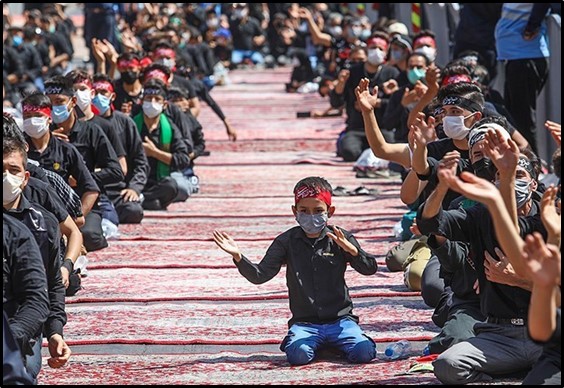
On August 16, Iran hit a record high 655 deaths from the coronavirus and could reach 800 per day in the coming weeks, Reuters reported. The government issued permits for U.S.-made Pfizer and Moderna vaccines despite an earlier ban by Supreme Leader Khamenei. Mohammad Reza Shanesaz, the head of the Iranian Food and Drug Administration, said that the vaccines came from "permissible sources."
On August 17, Iran received an additional 700,000 vaccine doses from China, according to the Iranian foreign ministry. Beijing had sent a total 1.55 million doses to Iran since February, said Reza Zabib, the director general of the Asia-Pacific Department.
Iran had administered 12 million doses of China's Sinopharm vaccines, four million doses of the Oxford-AstraZeneca vaccine, one million doses of the domestically-produced CovIran Barekat and fewer than a million doses of Russia's Sputnik V and India's Covaxin vaccines, according to the head of virology research at the Pasteur Institute in Tehran.
On August 18, President Raisi sided with Beijing over its rejection of a second WHO probe into the origins of the coronavirus. "The politicization of the source of the COVID-19 pandemic is a serious threat to global health and is an example of some countries' efforts to isolate China," Raisi told Chinese President Xi Jinping in a phone call. Xi promised to do his "utmost to deliver the vaccine to Iran and help Iran overcome [the] coronavirus."
On August 19, the IRSC pledged to double the number of vaccines it imported in the following month. Karim Hemmati, president of the IRSC, said that the organization had been importing doses from China and would continue to do so. More than 100,000 Iranians have died from COVID-19 since February 2020, the health ministry reported.
On August 20, Iran expanded eligibility for the COVID-19 vaccine to all mothers working in health care or pregnant women over the age of 35. Women with spouses working in coronavirus hospital wards were also eligible, state-run IRNA reported. President Raisi told the National Coronavirus Task Force that Xi had promised to accelerate shipments of vaccines to Iran.
Week 80: August 22 – August 28
On August 22, IRGC commander Major General Hossein Salami announced that the Noura vaccine, developed by the IRGC-affiliated Baqiyatallah University of Medical Sciences, had entered the second phase of clinical trials.
On August 23, the national Union of Medicine Importers announced that Iran would receive 20 million doses of the previously-banned Pfizer vaccine by the end of 2021. The Iran Customs Administration said that the country had already imported 20.1 million Sinopharm vaccines from China, 2.9 million AstraZeneca vaccines from Japan, and 1 million Sputnik vaccines from Russia – in addition to smaller batches of vaccines from South Korea, India, and Italy – since February 3, 2021.
On August 24, Iran reported a record daily high of 709 deaths, raising the total death toll to 103,357.
On August 26, Hossein Amir-Abdollahian, the newly confirmed foreign minister, said that the foreign ministry had established a special headquarters dedicated to expediting the import of vaccines. On the same day, Iran received its seventeenth vaccine shipment, which contained 1.1 million doses. Iran had received a total of 20.39 million doses from abroad.
On August 28, Defense Minister Mohammad Reza Qaraei Ashtiani announced that the Iranian Fakhra vaccine reached its final phase of testing and would be mass-manufactured in the near future.
Week 81: August 29 – September 4
On September 2, Iran received its third shipment of vaccines through the COVAX Facility program.
On September 4, the Iranian health ministry refuted media reports which alleged that Iran had produced and exported two million doses of the Sputnik vaccine to Russia each month. “The transfer of any kind of vaccines into and out of the country is subject to permission by the [Iranian] Food and Drug Organization, and such a permit has not been issued, so far, for coronavirus vaccines,” said Kianoush Jahanbakhsh, the spokesman for the Iranian Food and Drug Organization.
In a live television interview, President Raisi, lauded domestic efforts to produce vaccines. But he acknowledged that Iran needed doses from abroad as well. He announced that Iran would import 40 million by mid-September 2021.
Week 82: September 5 – September 11
On September 5, President Raisi received his second dose of the CovIran Barekat vaccine. Meanwhile, the Iranian Red Crescent Society received its eighteenth consignment of COVID-19 vaccines, containing five million doses.
Major General Hassan Firouzabadi died from COVID-19 at age 70. He was appointed by Supreme Leader Khamenei to head the armed forces chief in 1989 and held the position until 2016.
On September 7, Austrian Foreign Minister Alexander Schallenberg tweeted, “I am pleased that Austria is supporting the people of #Iran with 1 million doses of #AstraZeneca #vaccines against #COVID19.”
The first half of a 1million doses donation of AstraZeneca vaccine from Austria was welcomed by an Austrian Embassy team led by CdA Barbara Grosse at IKA.Austria is convinced that joint efforts are needed to counter the global Covid19 crisis.Nobody is safe until everybody is safe pic.twitter.com/CP9J0XirAA
— Austrian Embassy Tehran (@AustriainIran) September 8, 2021
On September 8, the director of the Iran Pasteur Institute announced that the PastoCoVac vaccine, jointly developed by Iran and Cuba, passed the clinical test on children in Cuba. The vaccine was subsequently cleared for use on Iranian children.
On September 9, President Ebrahim Raisi said that his administration would fight the latest COVID-19 surge in four ways: supporting domestic vaccine production; importing more vaccines; accelerating vaccination programs; and implementing an updated “Martyr Soleimani” plan, in which thousands of volunteers go door-to-door screening people for COVID-19.
The health ministry said that the worst phase of the ongoing COVID-19 wave had passed.
On September 11, the Iranian Red Crescent Society said that Iran would soon vaccinate students aged 12 to 18.
Week 82: September 12 – September 18
On September 13, the Health Minister Bahram Einollahi said that Iran’s Fakhra vaccine passed to its third clinical trial with 40,000 volunteers.
Protestors gathered outside of the Interior Ministry to condemn mandatory vaccinations.
The Foreign Ministry said that Iran will remove any “red lines” for importing COVID-19 vaccines, including those developed by American companies Pfizer and Moderna.
On September 14, the Health Minister Einollahi said that Iran will import 40 million doses of COVID-19 vaccine between September 23 and October 22, 2021, the Iranian month of Mehr.
On September 15, a health official said that nearly 40 percent of Iranians had received their first dose of a COVID-19 vaccine.
On September 16, Mohammad Reza Shanehsaz, the head of Iran’s Food and Drug Administration, announced that two more vaccines were approved for use in Iran, the Johnson & Johnson vaccine developed in the United States and Russia’s Sputnik Light. Both were single-dose vaccines.
Week 83: September 19 – September 25

On September 21, President Ebrahim Raisi said that U.S. sanctions on Iran amid the COVID-19 pandemic, “especially in the area of humanitarian items,” amounted to an “organized crime against humanity.” In his debut address to the United Nations, Raisi condemned the punitive measures as “oppressive.” Under U.S. law, humanitarian goods are not subject to sanctions, but some U.S. and foreign companies and banks have been reluctant to do business with Iran for fear of running afoul of the complex U.S. sanctions regime.
The Barekat Foundation said that it had delivered six million doses of the domestic CovIran Barekat vaccine to the health ministry.
On September 22, Iranian Foreign Minister Hossein Amir-Abdollahian thanked his Austrian counterpart Alexander Schallenberg for his country’s vaccine donations. The two met on the sidelines of the U.N. General Assembly.
On September 25, Iran kicked off a new school year with relaxed restrictions on in-person learning for some 15 million students. The public school system planned a gradual reopening that combined distance learning and in-person instruction, especially for larger schools.
Week 84: September 26 – October 2
On September 26, the health ministry reported that more than 50 million vaccination doses had been administered. More than 35 million people had received one dose, and more than 15 million had received two doses.
On October 2, Iran announced that more than 62,000 vaccine doses had been administered to Afghan nationals in northeastern Razavi Khorasan province.
Iran alleged that U.S. sanctions were hindering efforts to import vaccines. “The inhumane and illegal unilateral coercive measures have even denied the allocation of COVID-19 vaccines to the Islamic Republic of Iran,” Mohammad Ghorbanpour, first secretary at Iran’s U.N. mission, told a U.N. General Assembly committee. “It is a matter of great regret that certain countries brazenly claim that humanitarian goods are exempt from sanctions – that in itself is a terrible lie.”
Week 85: October 3 – October 9
On October 3, acting Education Minister Alireza Kazemi said that schools would reopen on November 6. Kazemi also stated that kindergartens in yellow and orange-level cities could resume in-person instruction.
On October 5, Deputy Health Minister Mohammad Rez Shanehsaz announced that Iran had received its first shipment of the PastoCoVac vaccine, jointed developed by Iran and Cuba. The first shipment included 6 million doses.
On October 6 and 7, 95 vaccination centers across Tehran were opened for students aged 12 to 18.
Week 85: October 3 – October 9
On October 6, the Iranian Food and Drug Administration issued an emergency authorization for the use of the Spikogen (also “Spicogen”) vaccine, an Iranian-Australian joint research venture.
On October 9, President Ebrahim Raisi urged citizens to follow health protocols and avoid unnecessary gatherings. He acknowledged that the number of daily infections and deaths had decreased but warned that “not following health protocols and normalization are dangerous and can pave the way for a new wave of disease.”
Week 86: October 10 – October 16
On October 11, the Iranian Food and Drug Administration said that, in two weeks, Iran will no longer need additional vaccine imports. But Iran will continue to receive any further deliveries established by extant agreements.
On October 12, Iran’s Ravi Vaccine and Serum Research Institute announced that the third dose of the Razi Cov Pars vaccine - delivered intranasally rather than via injection, unlike the first two doses – could reduce virus transmission by 90 percent.
On October 13, Iran received 400,000 doses of the Sputnik-V vaccine from Russia after months of delays.
Week 87: October 17 – October 23
On October 20, the defense ministry announced that it would cease production of its Fakhravac vaccine, citing insufficient demand. “We are in the process of planning to end production, because who will we sell it to?” Ahmad Karimi, the Fakhravac program director, asked rhetorically.
On October 22, Tehran held the first public Friday prayer service in 20 months.
Week 88: October 24 – October 30
On October 24, Iran received six million doses of the Chinese Sinopharm vaccine. Iran “will keep importing the Sinopharm vaccine,” Iranian Red Crescent Society director Karim Hemmati said.

On October 25, Health Minister Bahram Einollahi said that unvaccinated individuals constituted over 85 percent of deaths from COVID-19. He expressed concern about the potential for a sixth wave due to the segment of the population refusing vaccination.
On October 30, President Raisi directed government ministries, led by the Ministry of Health, to “make plans to reopen schools and universities on November 22.”
Week 89: October 31 - November 6
On November 1, Iranian state television reported that Foreign Minister Hossein Amir Adbollahian had tested positive for COVID-19. But his condition was “good,” and he was able to work while in quarantine, according to Foreign Ministry Spokesperson Saeed Khatibzadeh.
The Iran Customs Administration reported that Iran had cumulatively imported 146,246,308 doses of coronavirus vaccines.
On November 3, the number of cities designated “red” rose to 29. Minister of Interior Ahmad Vahidi urged the public to observe public health protocols to prevent a sixth wave.
Week 90: November 7 - November 13
On November 7, Health Minister Bahram Einollahi attributed the rise in COVID-19 cases among some cities to Iranians failing to observe public-health protocols.
The Food and Drug Administration announced that Iran’s was producing 10 million vaccine doses per month.
On November 11, First Vice President Mohammad Mokhber called on officials to speed up the administration of booster doses. He also urged the public to comply with health protocols.
On November 13, President Raisi called on the Health Ministry to pre-purchase domestic vaccines to support local companies. Advanced orders “can make them more hopeful about continuing and expanding their activities,” he said.
Week 91: November 14 – November 20
On November 20, the health ministry announced that 44 million people – or over half of the 85 million-person population – were fully vaccinated.
Week 92: November 21 – November 27
On November 21, President Raisi ended the nighttime driving ban that had been in place for more than a year in many regions.
On November 23, Mohammad Mehdi Gooya, the head of the Ministry of Health’s diseases management center, said that Iran had outpaced Europe in administering first vaccine doses to individuals over age 12– at 82 versus 64 percent.
Week 93: November 28 - December 4
On December 4, President Raisi urgedIranians to abide by “health protocols and serious monitoring.” But he said that vaccinating young children “should not be done until accurate research and scientific work” has been completed. “The government will refrain from anything that has not been tested and approved,” he added.
Week 94: December 5 - December 11
On December 5, Raisi said that one of his government’s main achievements was the administration of more than 100 million vaccination doses. In a televised interview marking his government's first 100 days in office, Raisi said that more than 100,000 businesses had reopened as a result of vaccination efforts.
The Health Ministry recommended that individuals over the age of 40 receive booster shots.
Week 95: December 12 - December 18
On December 12, Supreme Leader Khamenei thanked nurses for their sacrifices during the pandemic. At an event marking National Nurse Day, he hosted nurses and the families of healthcare workers who had died from COVID-19.
On December 18, Iran received 26,400 doses of the AstraZeneca vaccine from the COVAX Facility.
The Islamic Republic of Iran, as one of the self-financing participant countries of the #COVAX Facility, has received a batch of 26,400 AstraZeneca #COVID19 vaccines on Saturday, 18 December 2021.
— UNICEF Iran (@UNICEF_IRAN) December 19, 2021
🇮🇷🇺🇳😷 pic.twitter.com/wL5EcxaqhX
Week 96: December 19 - December 25

On December 21, Foreign Ministry spokesperson Saeed Khatibzadeh announced the death of Iran’s ambassador to Yemen, Hassan Irloo, from COVID-19. The Saudi-led military coalition fighting the Houthis initially denied Irloo passage out of the country. But Saudi Arabia reportedly relented after Iraq and other regional countries weighed in. Irloo, allegedly a member of the Revolutionary Guards, left Yemen on December 19. But he was severely ill “due to the late cooperation of some countries,” Khatibzadeh said in what appeared to be a reference to Saudi Arabia.
Week 97: December 26 - January 1
On January 1, President Ebrahim Raisi urged the vaccination of incoming Afghan immigrants to prevent the spread of COVID-19 in Iran. Raisi added that “it is necessary for the border provinces to carefully and seriously control the traffic from land, air and sea borders.”
2022
Week 98: January 2 - January 8
On January 2, the Noora vaccine – under development at the Revolutionary Guards-affiliated Baqiyatallah University of Medical Sciences – entered the third phase of human trials. IRGC Commander-in-Chief Hossein Salami received a Noora dose as part of this stage of the trial.
Week 99: January 9 - January 15
On January 15, President Raisi announced that the government would permit the resumption of “sports competitions and exhibitions” with limited spectators. Raisi also urged Iranians to maintain compliance with public-health protocols, especially while utilizing public transit.
The health ministry reported Iran’s first deaths from the Omicron variant. Three individuals - based in the cities of Tabriz, Yazd, and Shahrekord - died from the latest mutation of COVID-19.
Week 100: January 16 - January 22
On January 19, the European Union’s Directorate-General for European Civil Protection and Humanitarian Aid Operations (ECHO) announced the delivery of 2.2 million vaccine doses from Spain to Afghan refugees in Iran - following a request from the Iranian government. The European Commission funded “coordinated the delivery and finances 75% of the costs for transporting the assistance,” according to ECHO’s statement.
Embajador Angel Losada hace entrega al Viceministro de asuntos económicos del Min. de Sanidad de 🇮🇷 de 2,2 millones de vacunas contra la #COVID19 donadas por #España para los refugiados afganos en #Irán a través del Mecanismo Europeo de Protección Civil pic.twitter.com/BtxolK2Kuh pic.twitter.com/kNRTSnsFfu
— España en Irán (@EmbEspIran) January 19, 2022
On January 22, President Raisi urged“mass media and scientific figures” to better convey the necessity and effectiveness of COVID-19 vaccines in order to persuade skeptical Iranians into receiving all three of recommended doses.
Week 101: January 23 - January 29
On January 24, the national COVID-19 science committee announced that Omicron had overtaken Delta and other variants. “Over 50% of transmissions are linked to the Omicron variant, it is safe to say that Omicron has become dominant,” Secretary Masoud Younesian said. “Since early January, we’ve been seeing a 10-12% increase in infections every day.”
On January 26, for a the first time in 47 days, a city was designated red – the highest level of health emergency due to the pandemic.
Week 102: January 30 - February 5
On January 31, Iran canceled in-person parliamentary sessions for two days after 47 of the 290 lawmakers tested positive for COVID-19. Ten were hospitalized for treatment.
The number of cities designated red reached 15. The number of cities designated orange, the second-highest level of emergency, rose from eight to 61.
On February 5, The Pasteur Institute of Iran announced that the PastoCoVac vaccine, a joint research collaboration between Iran and Cuba, was “70 percent effective in preventing infection and 100 percent efficient in preventing death” from the Omicron variant.
Week 103: February 6 - February 12
On February 7, Supreme Khamenei received his third dose of the domestic CovIran Barekat vaccine.
On February 11, Iranians marked the 43rd anniversary of the Islamic Revolution with rallies in some 4,500 cities and towns, although most were outdoor parades of cars, motorcycles and bicycles, with few people participating on the streets. In his televised address, President Raisi praised government efforts to combat the pandemic. “The day we started took office, 700 people were losing their lives every day because of coronavirus. But today, thanks to God Almighty and the help of the people and health officials, the situation is different.”
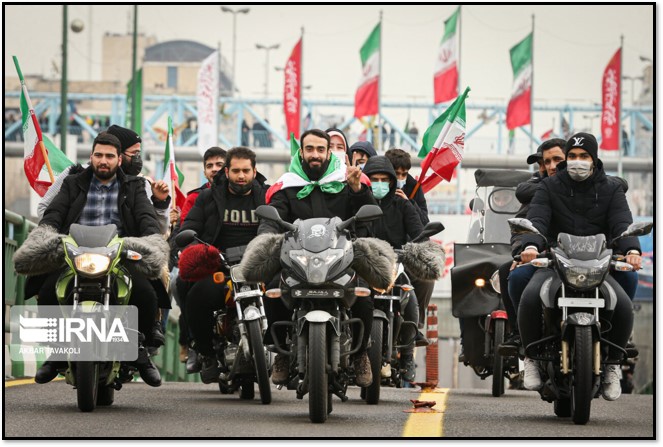
On February 12, President Raisi urged all executive bodies to insist on holding off “meetings and ceremonies unless necessary.”
Photo credits: All photos via Tasnim News Agency (CC by 4.0)
Tess Rosenberg, a research analyst at the U.S. Institute of Peace, and Garrett Nada, the managing editor of The Iran Primer, assembled this report building on prior work by Alex Yacoubian and Andrew Hanna.
